An Introduction to GNSS Presentation Outline GNSS Overview

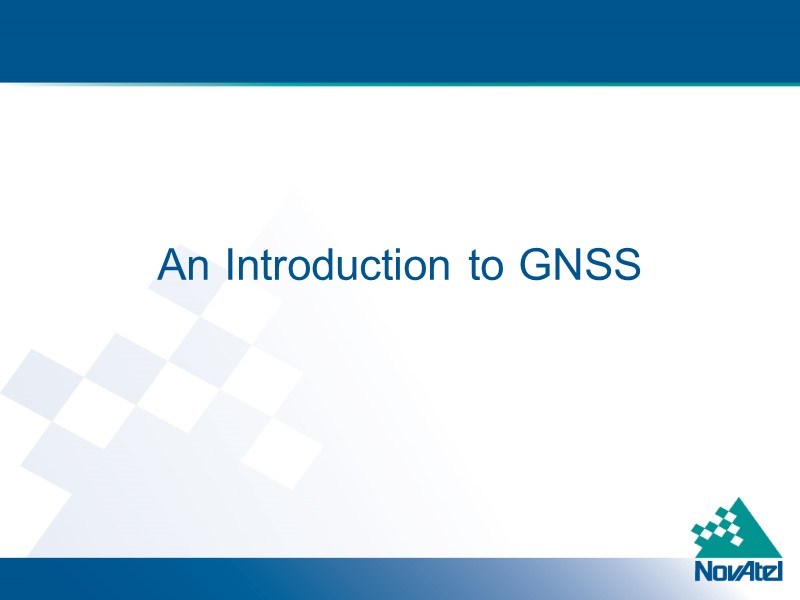
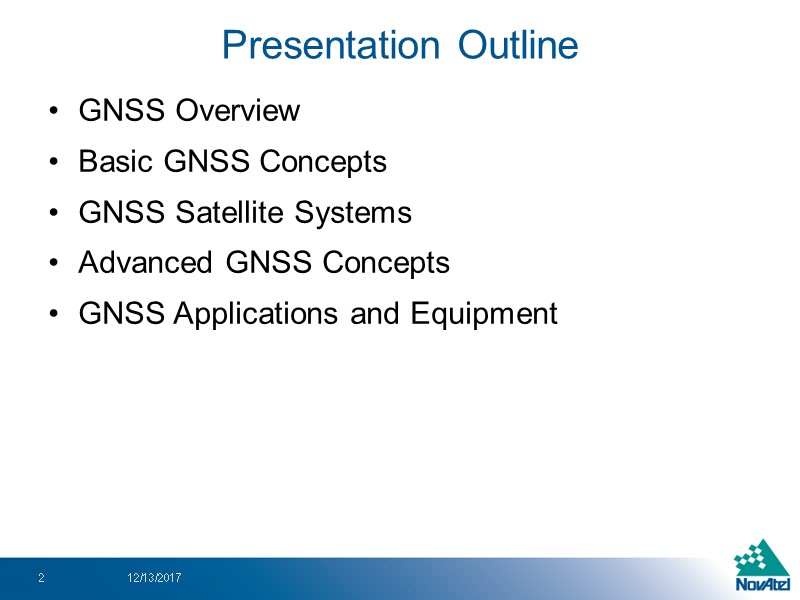
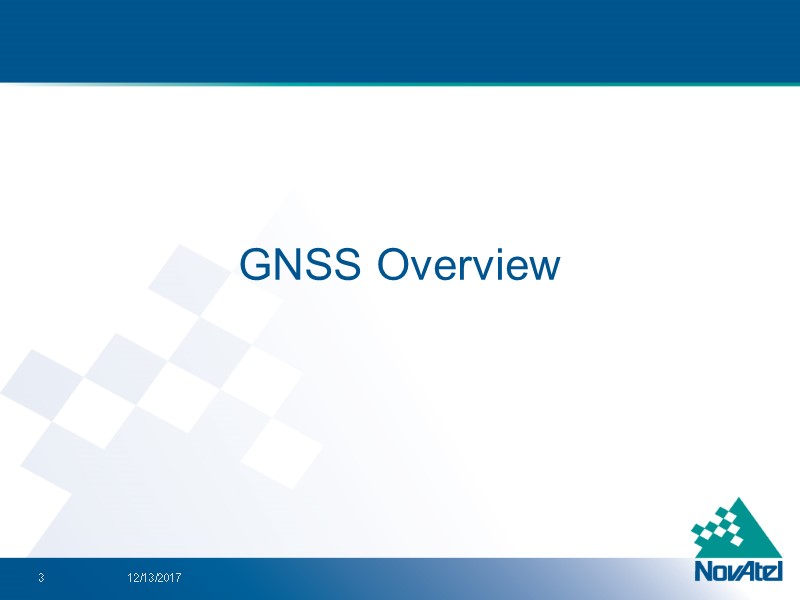
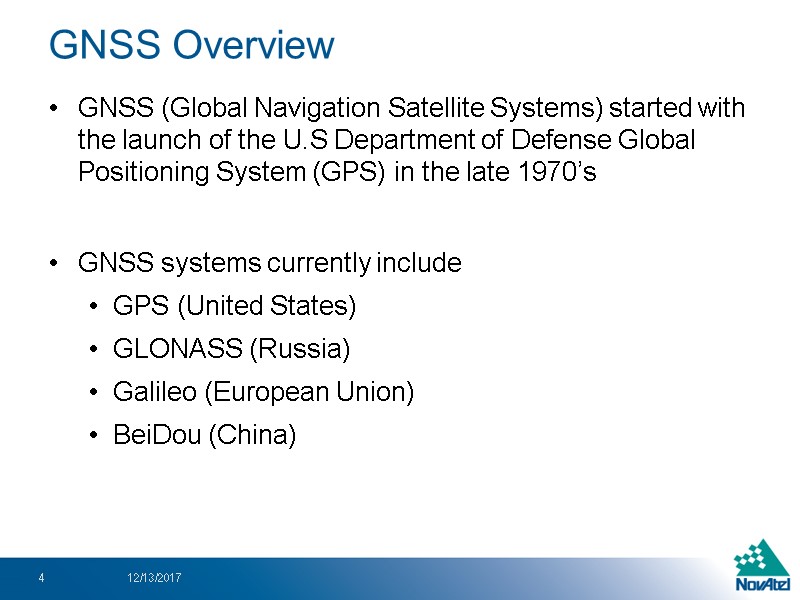
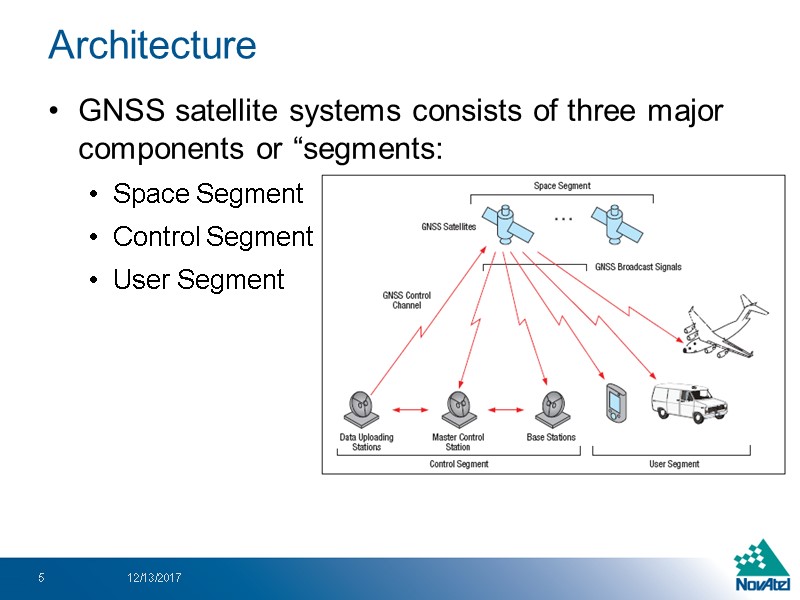
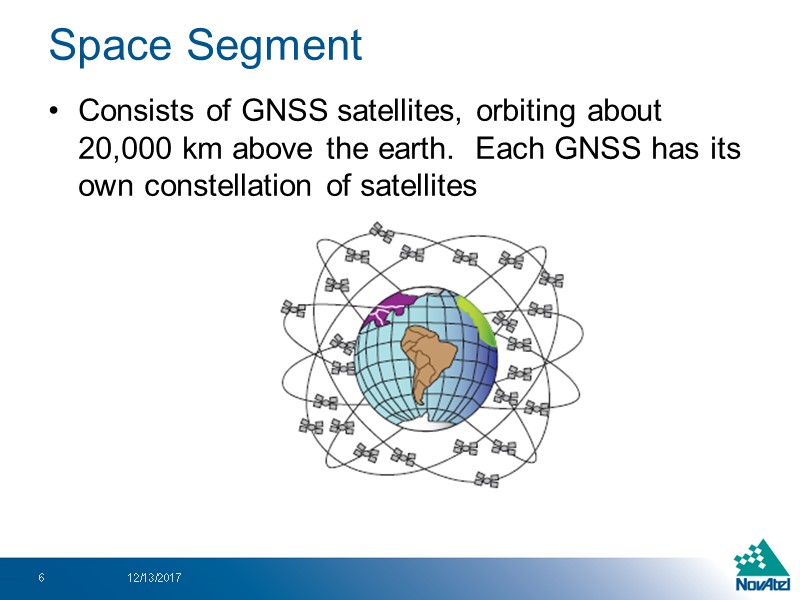
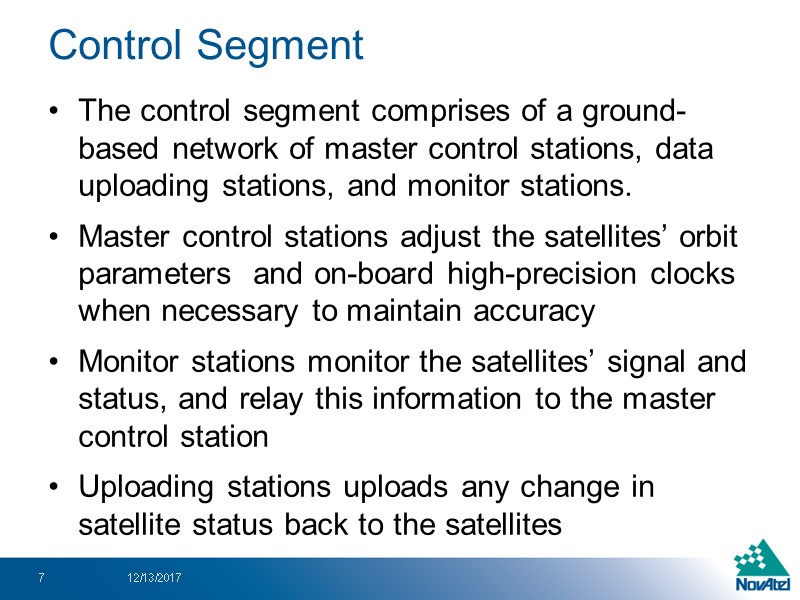
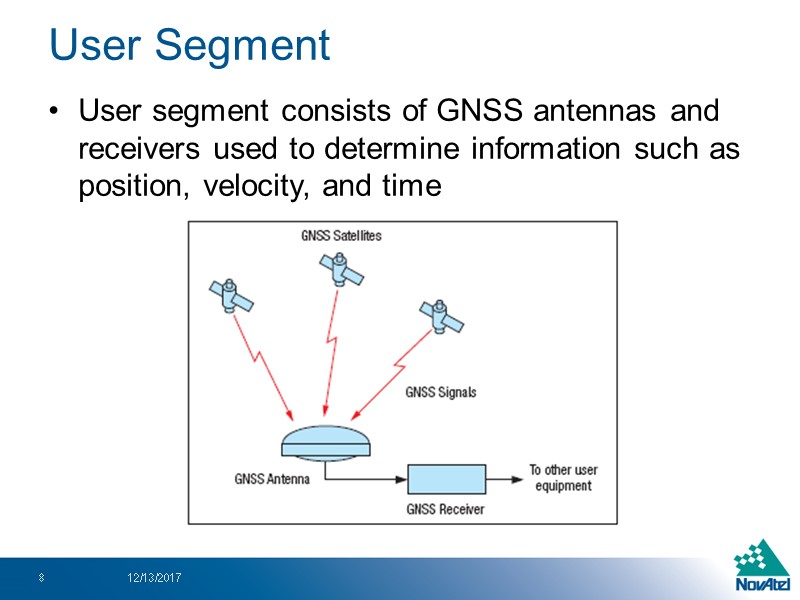
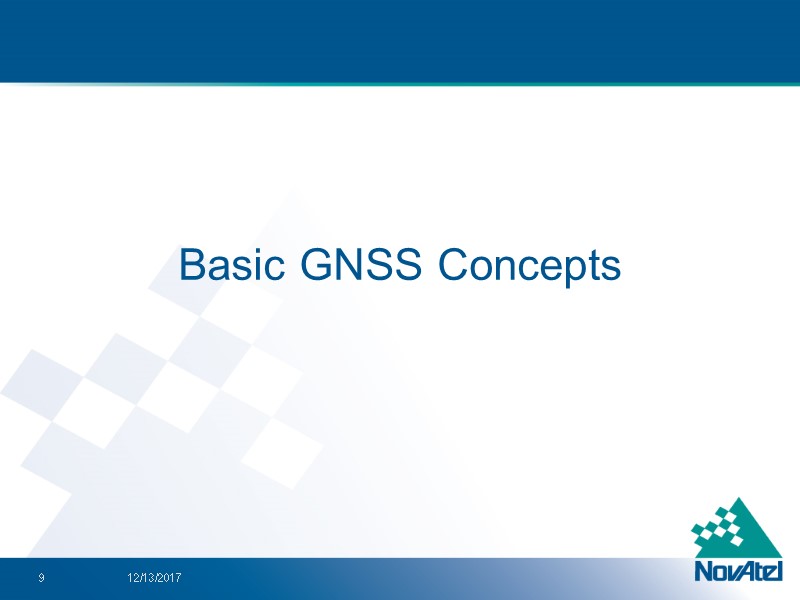
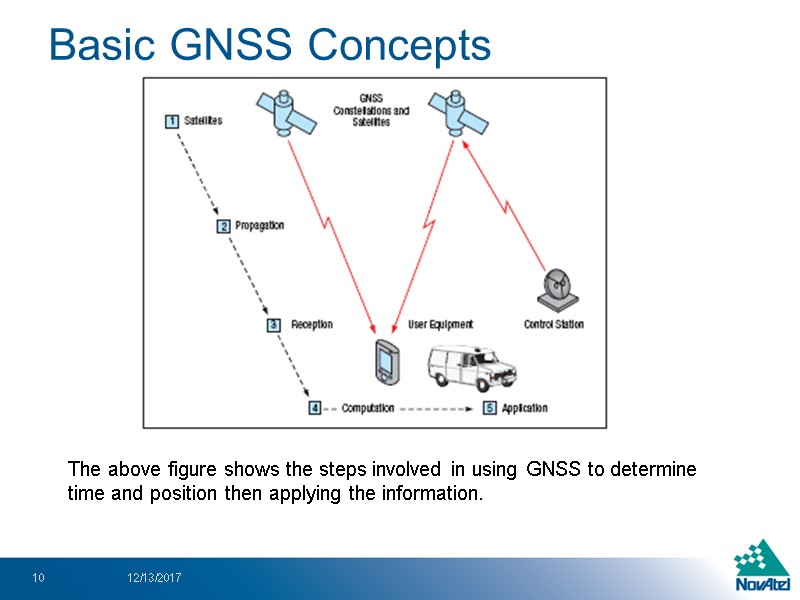
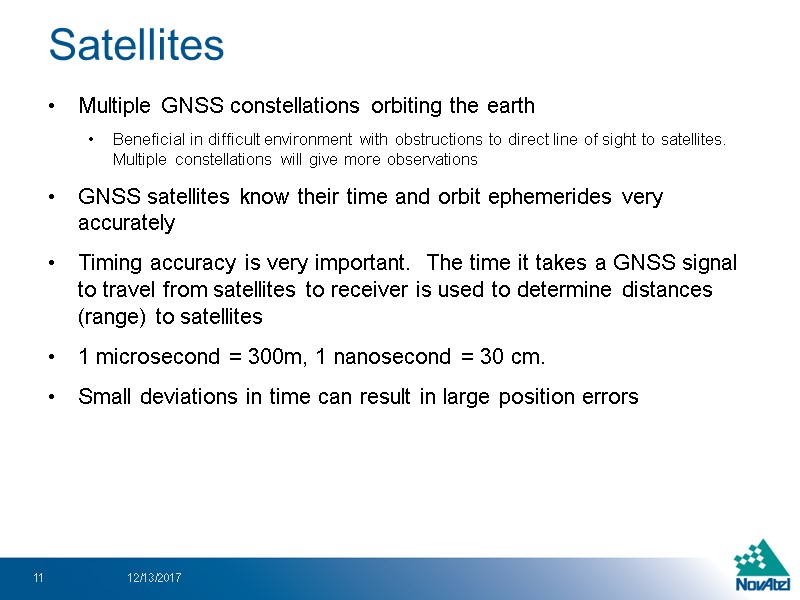
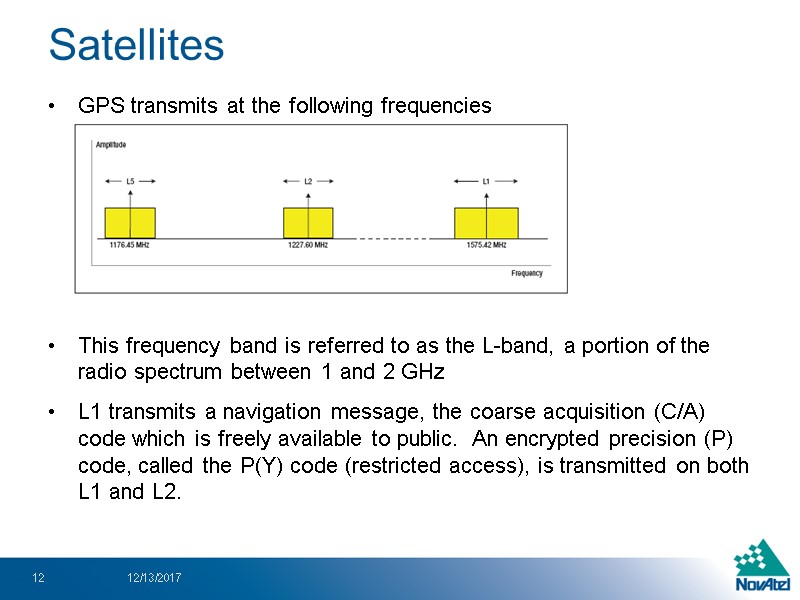
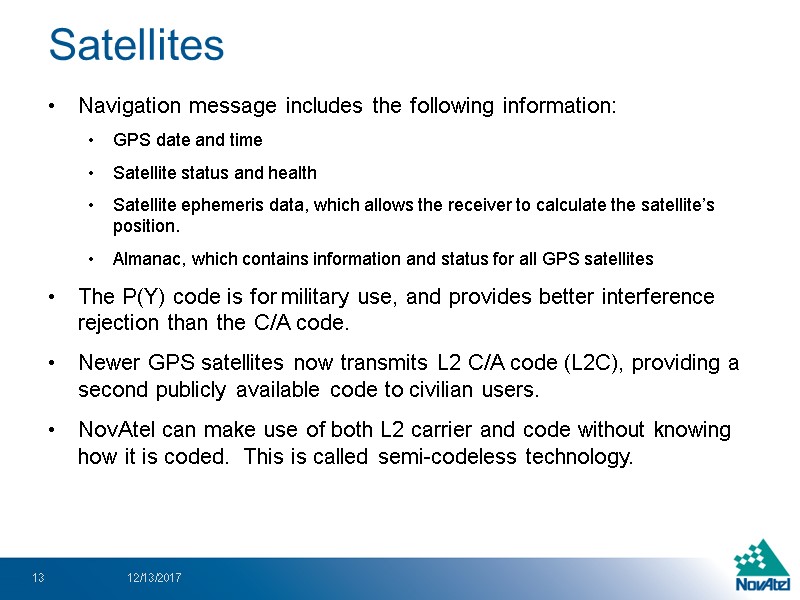
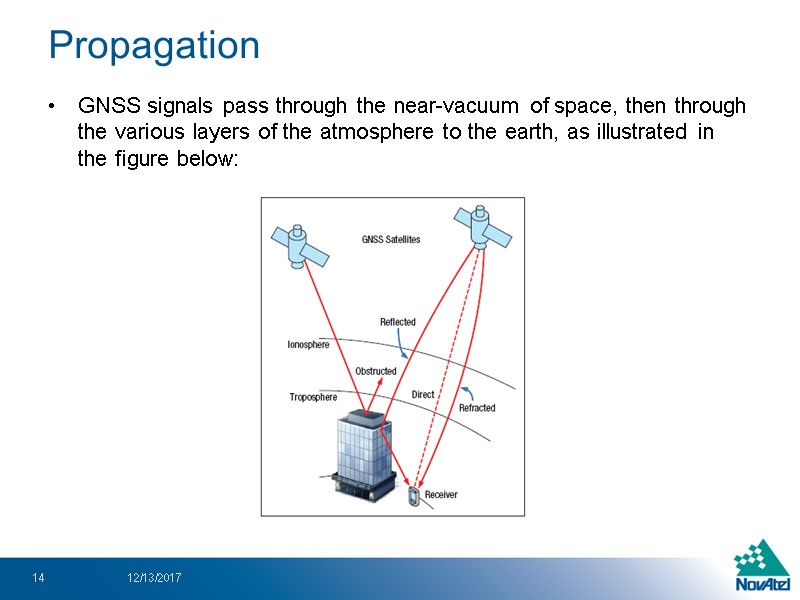
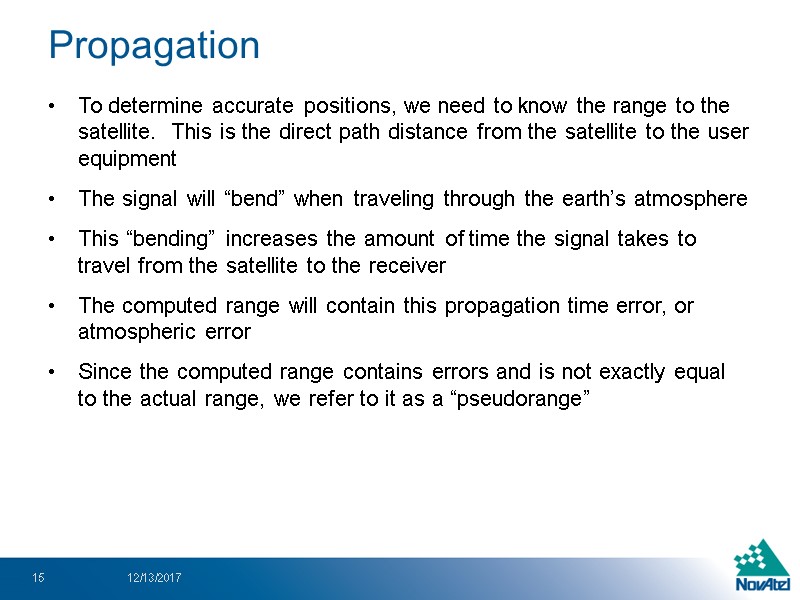
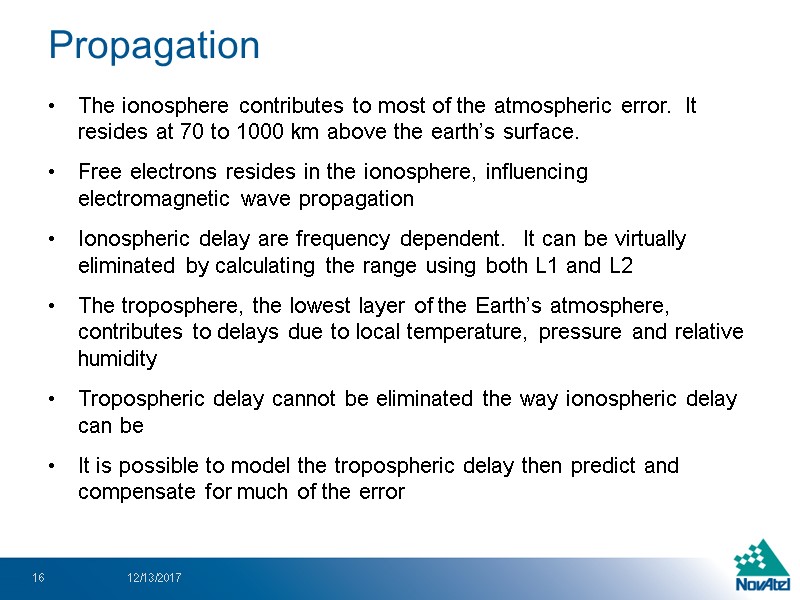
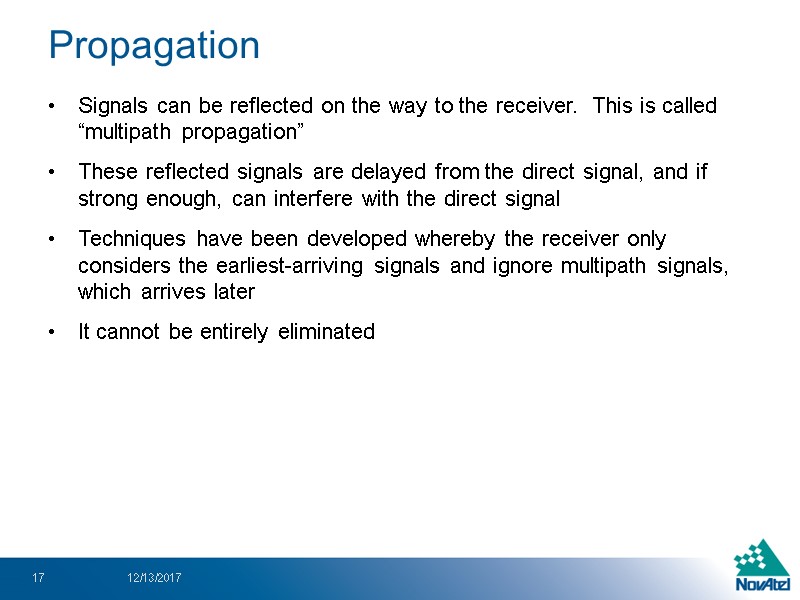
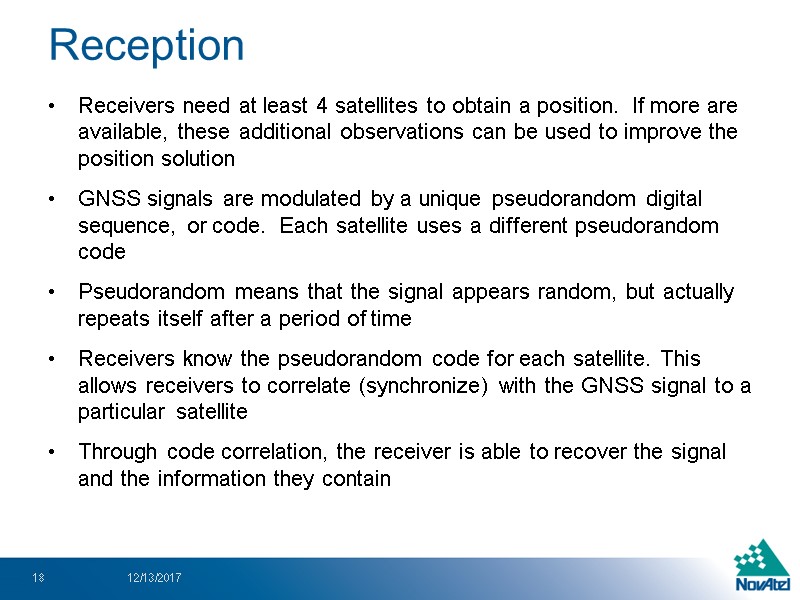
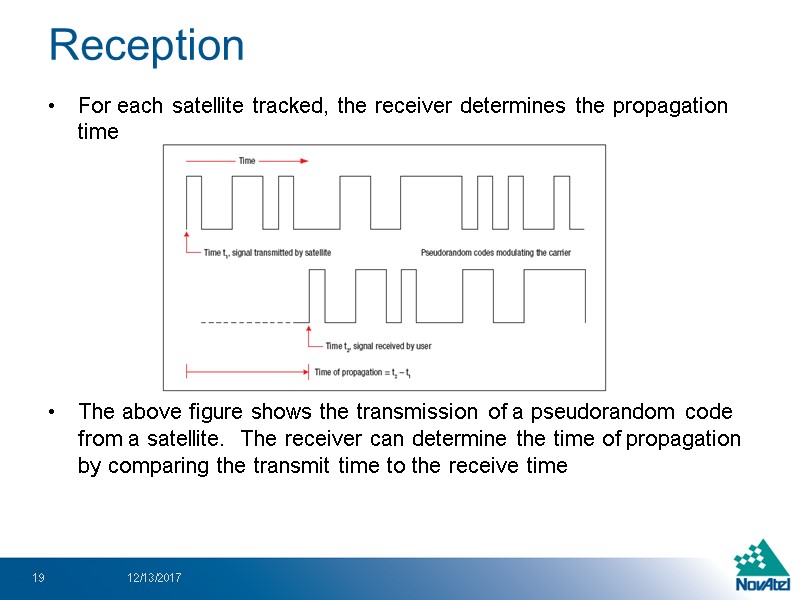
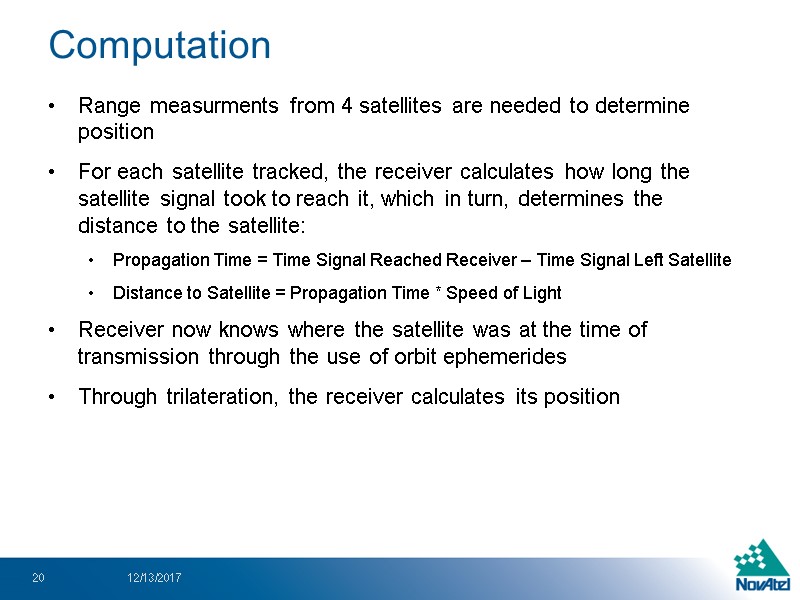
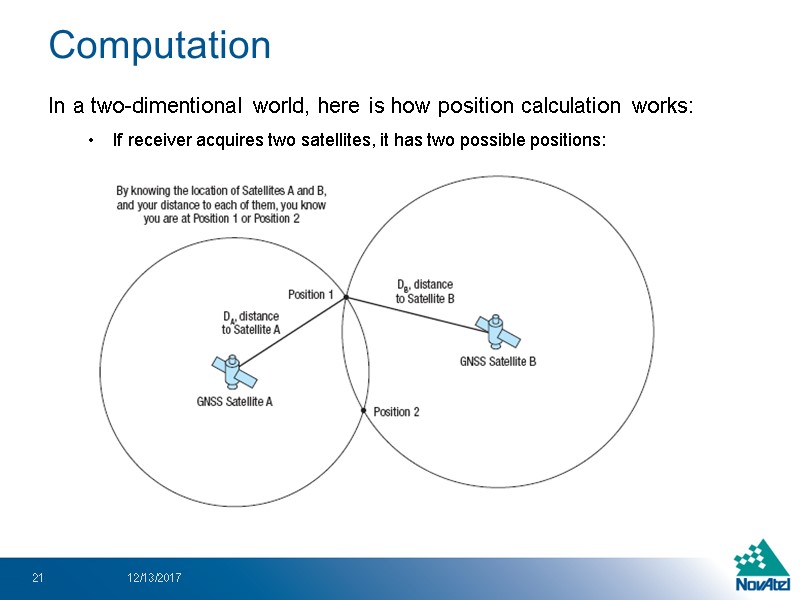
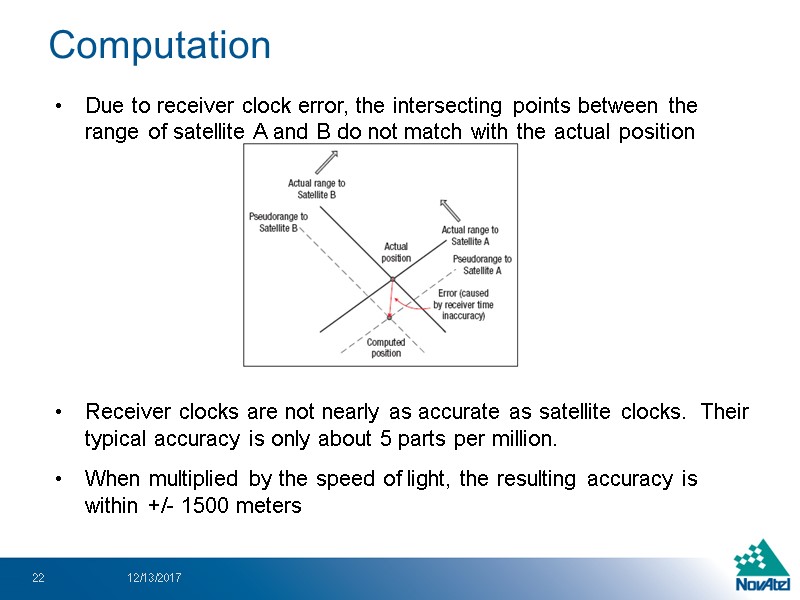
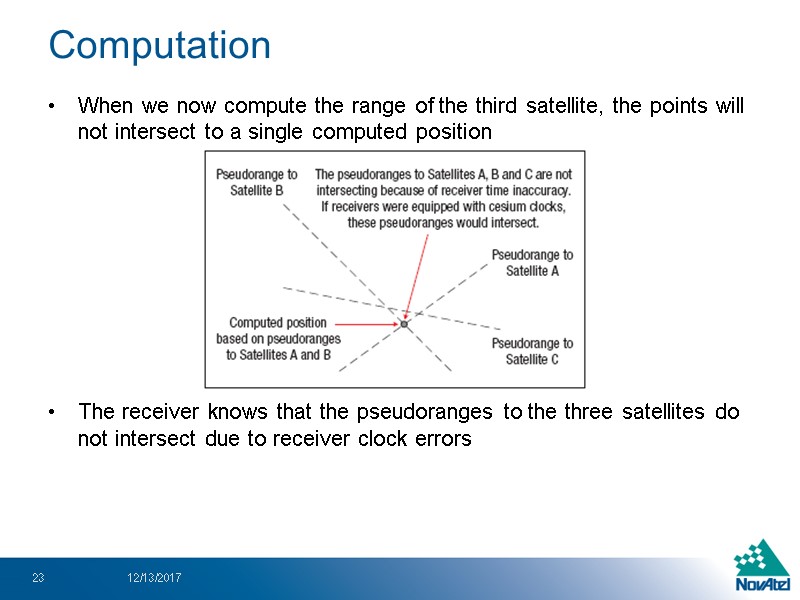
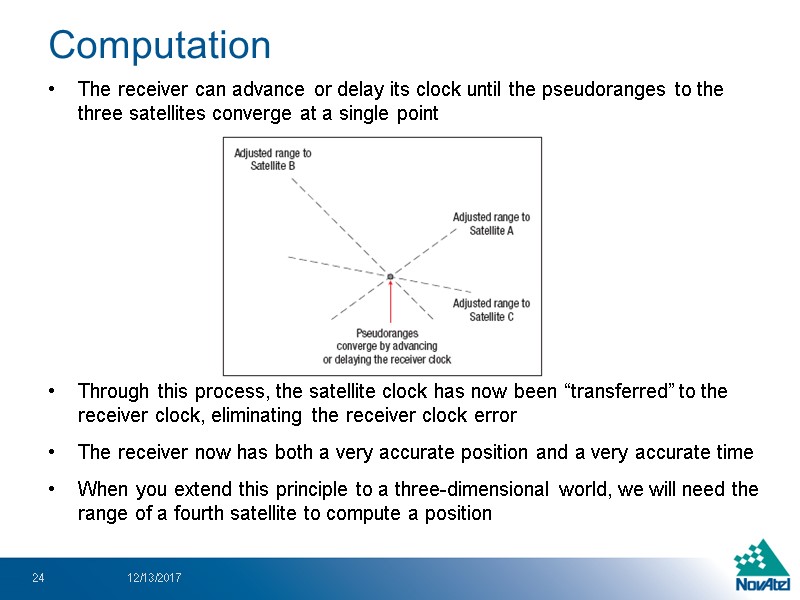
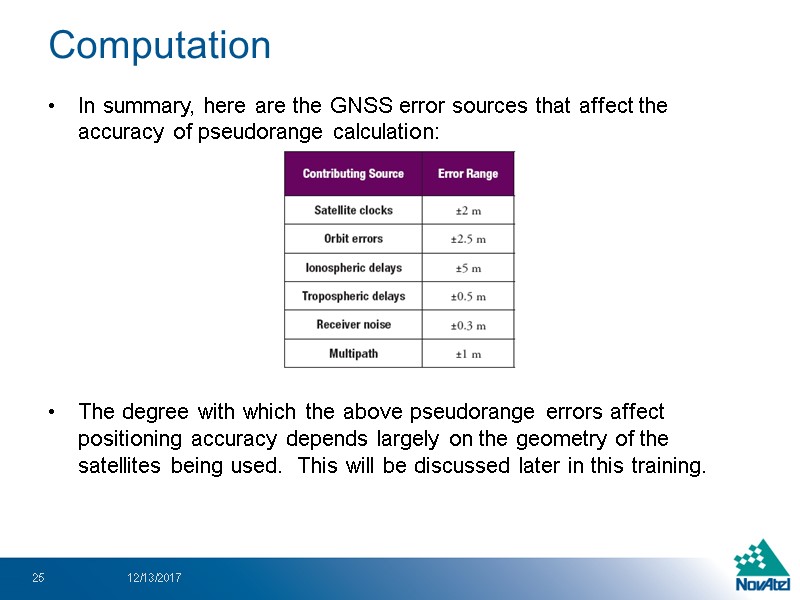
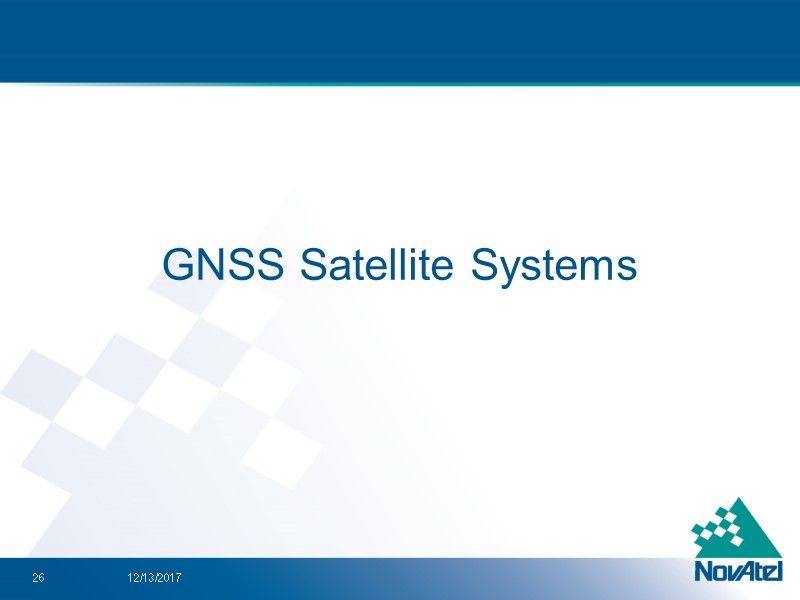
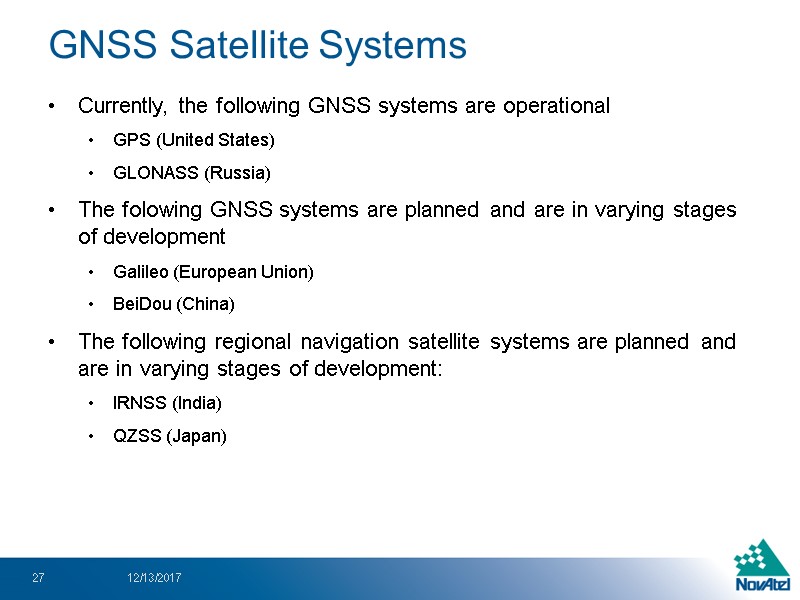
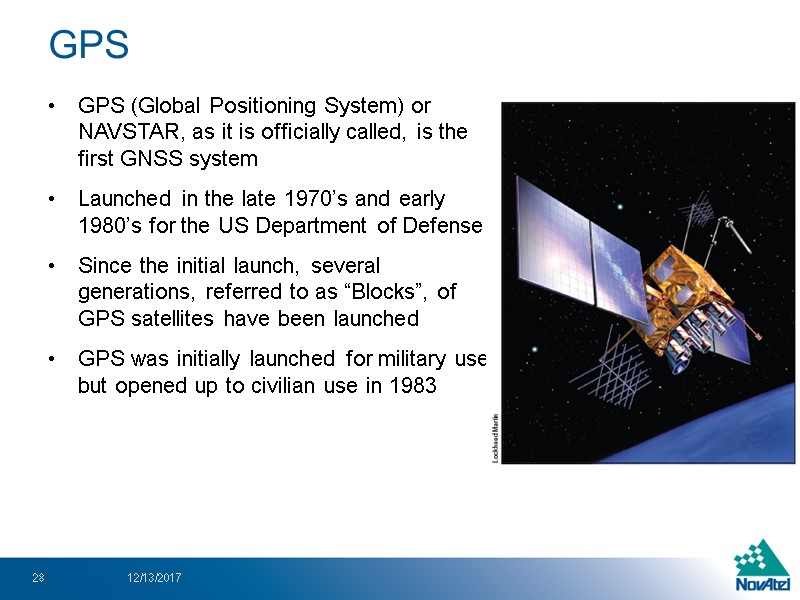
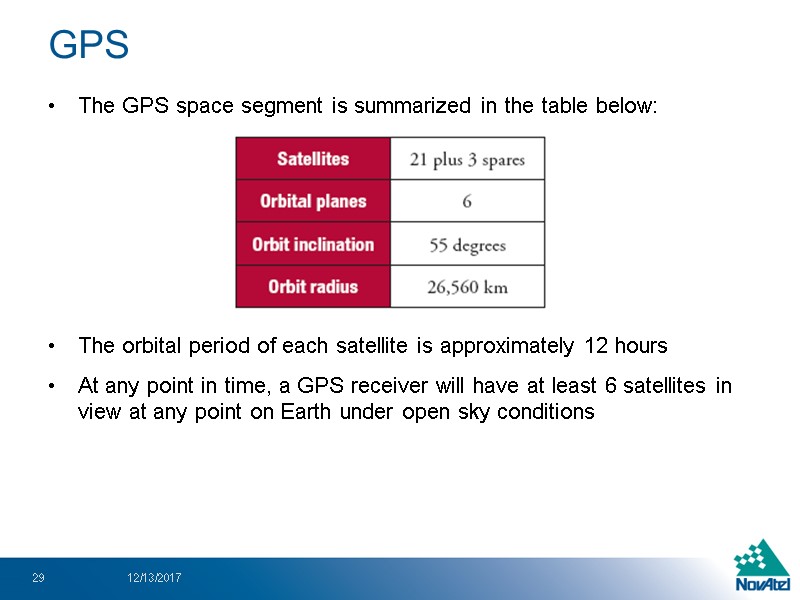
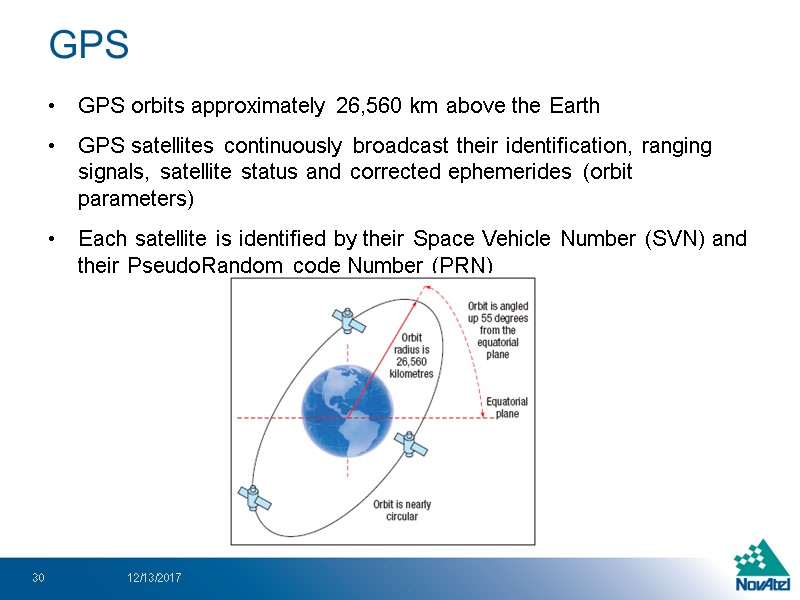
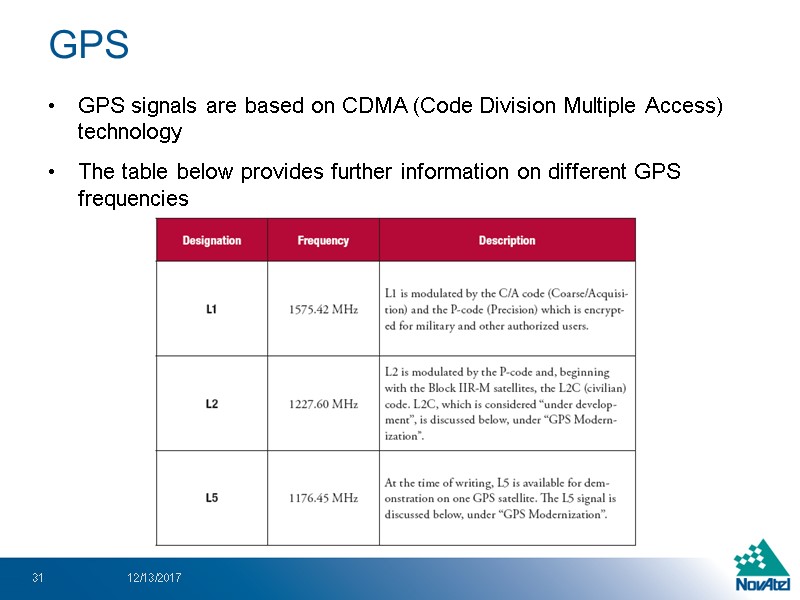
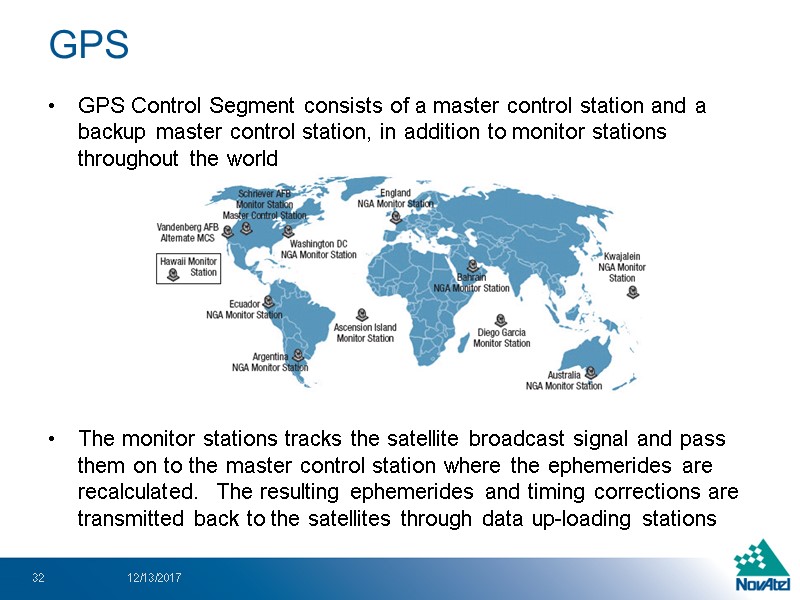
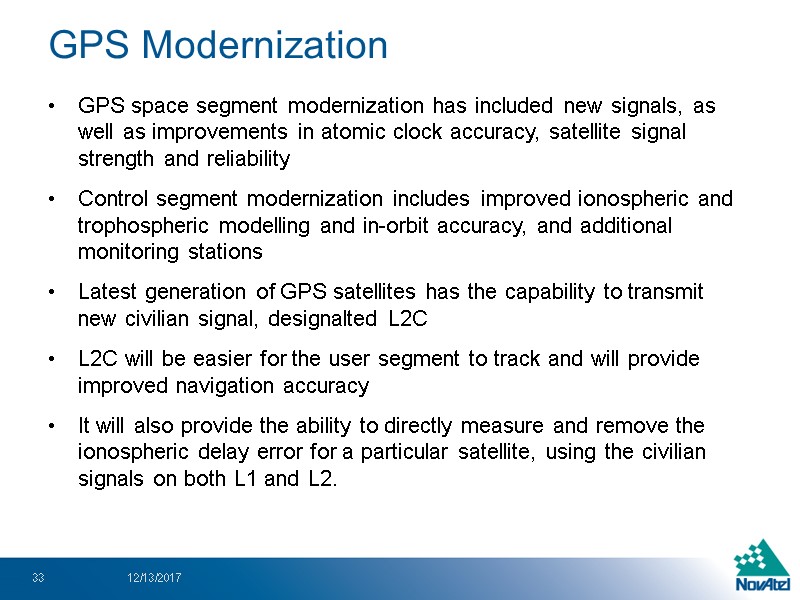
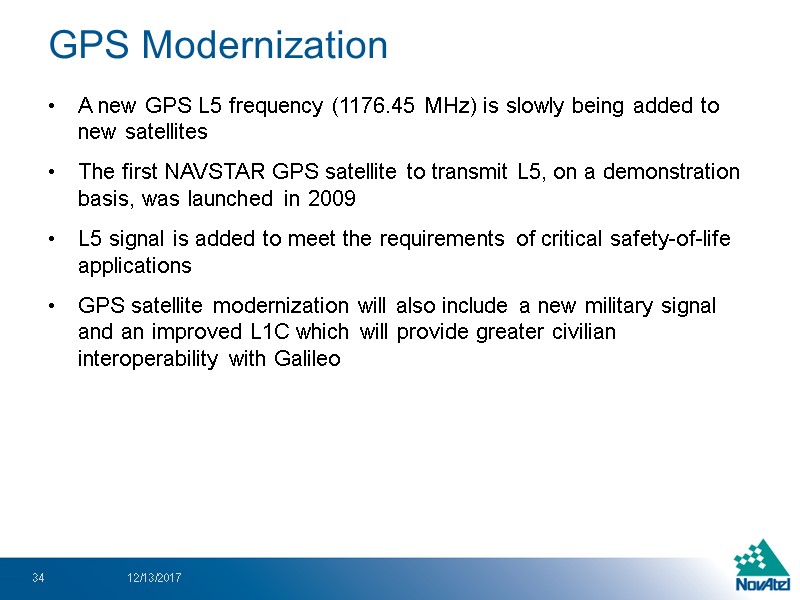
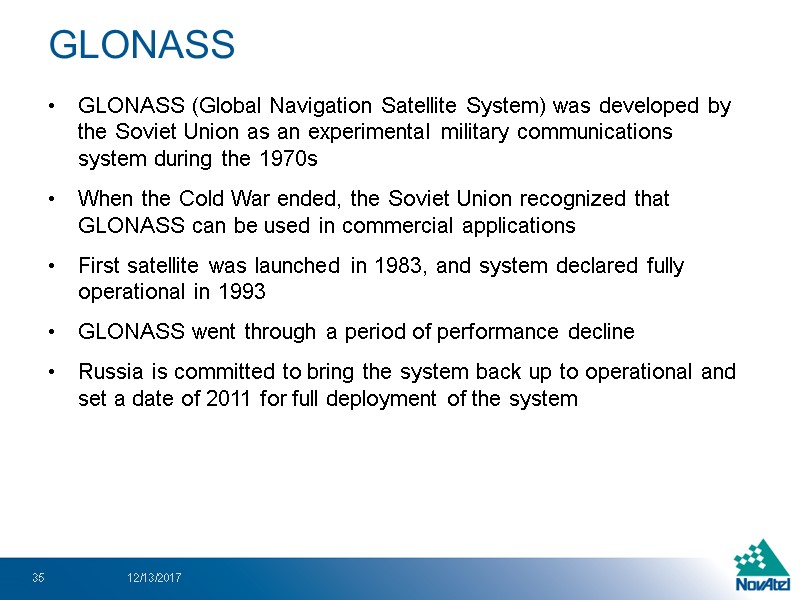
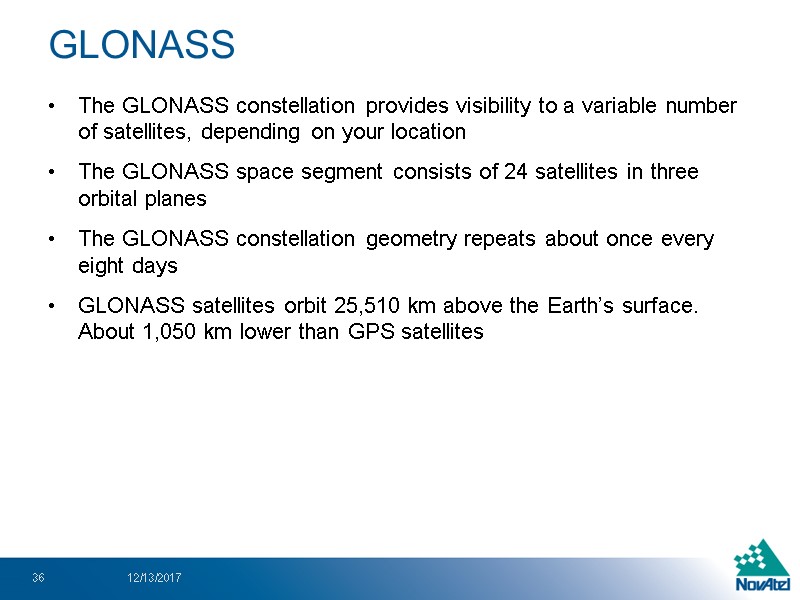
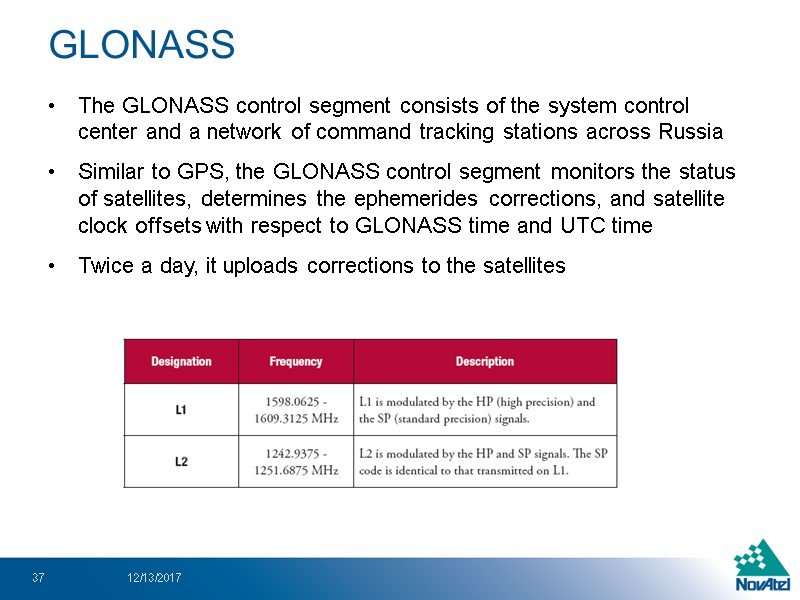
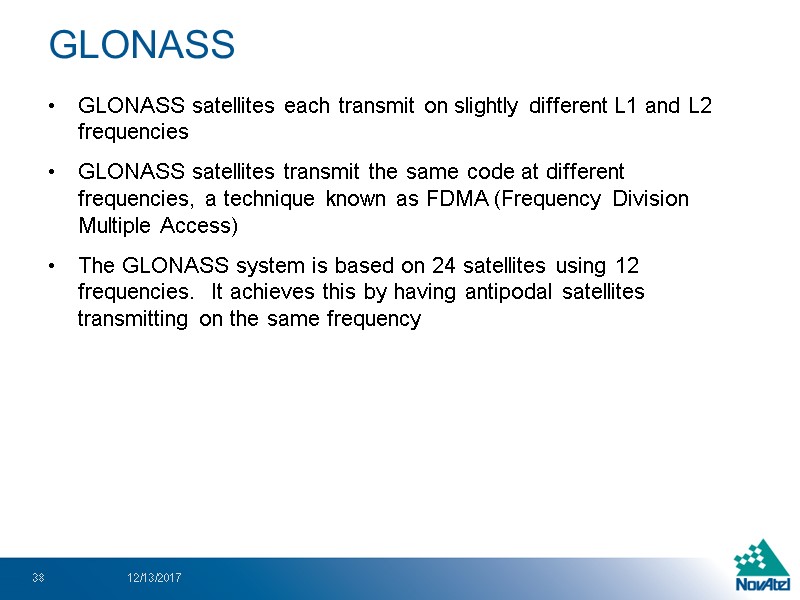
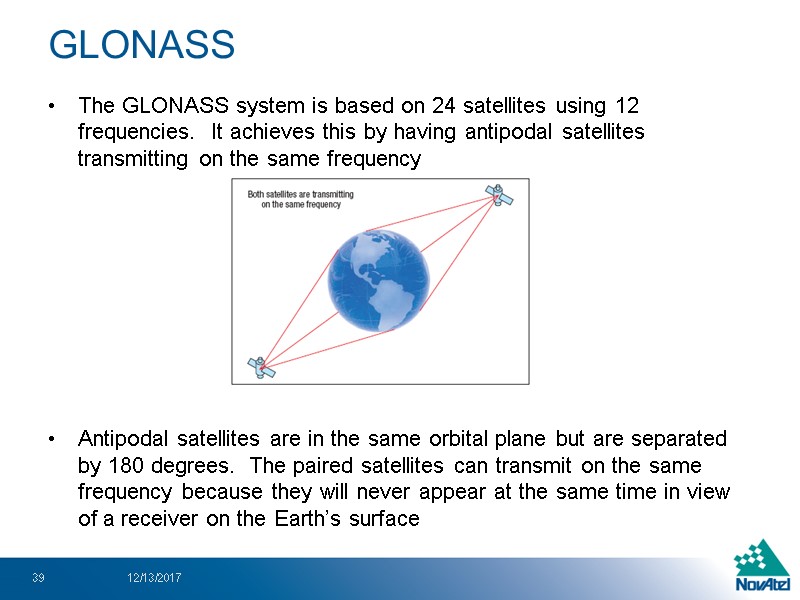
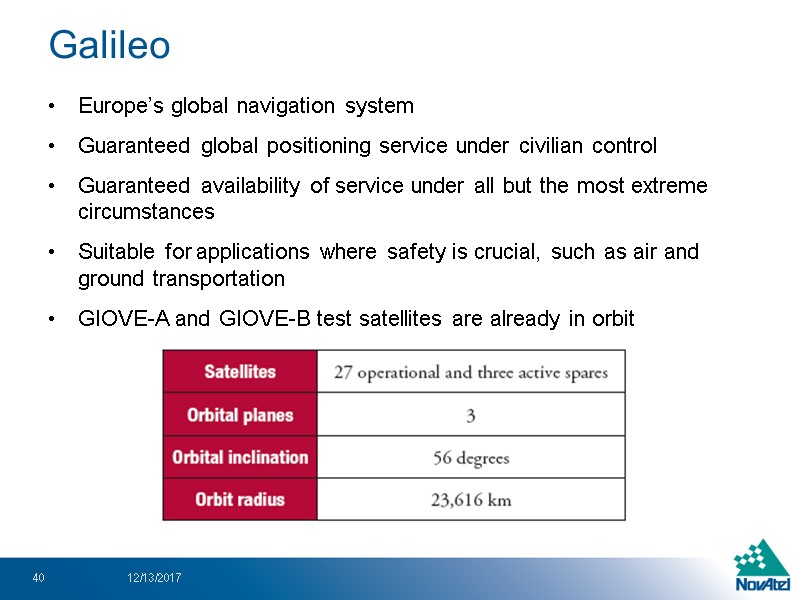
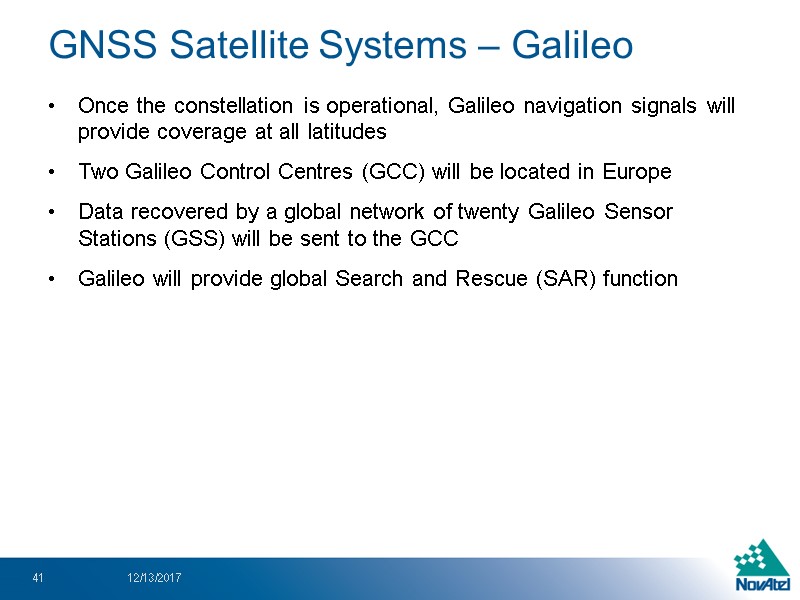
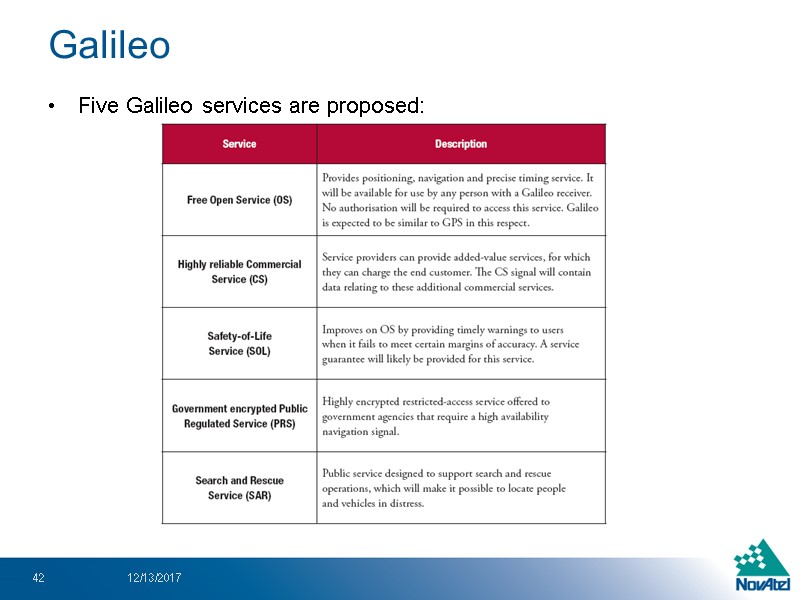
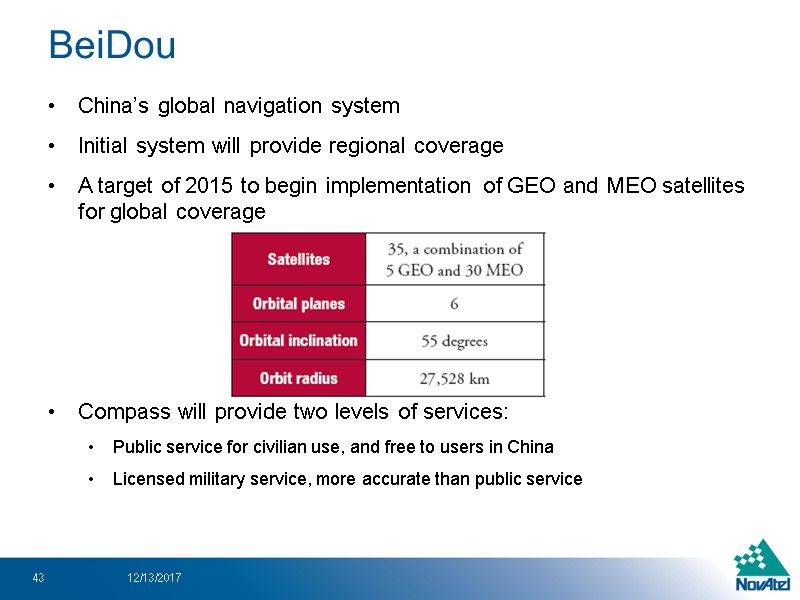
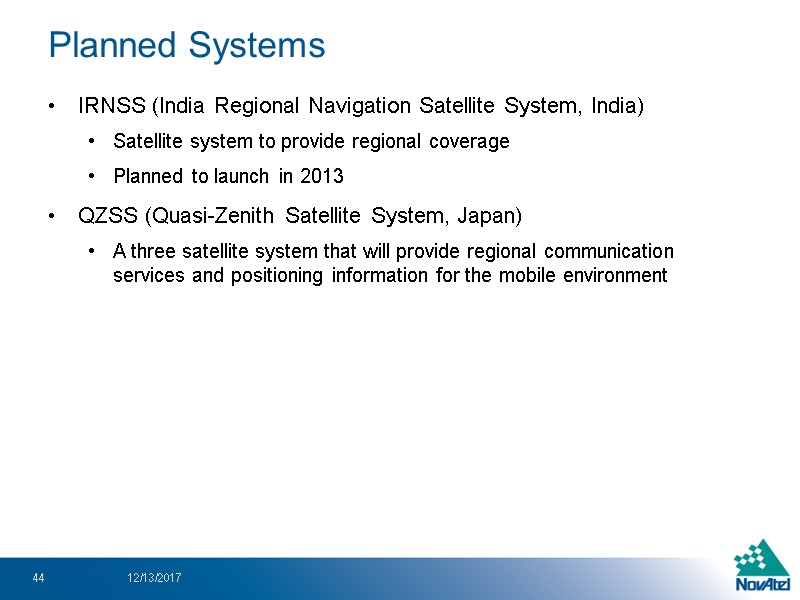
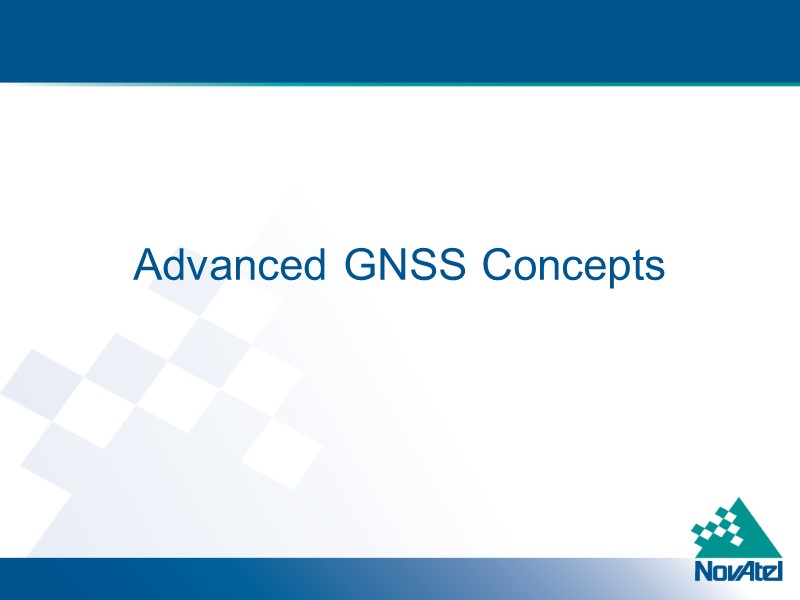
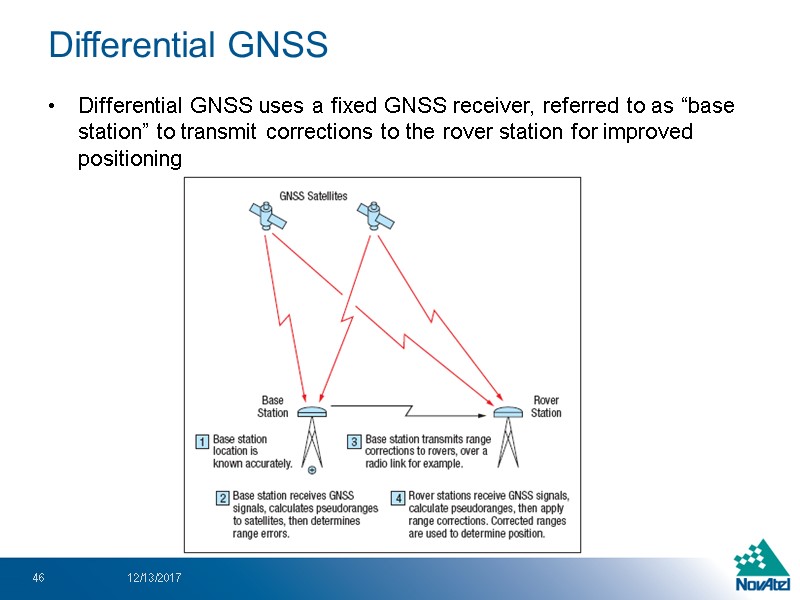
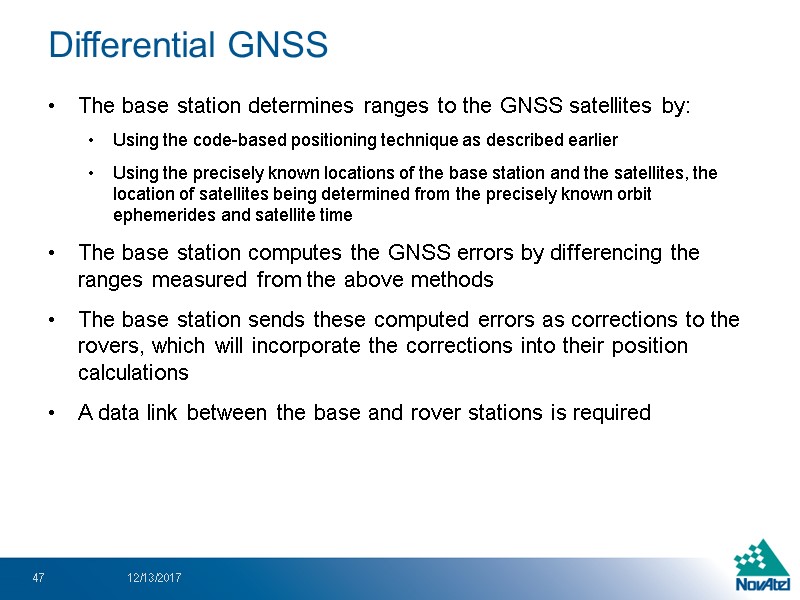
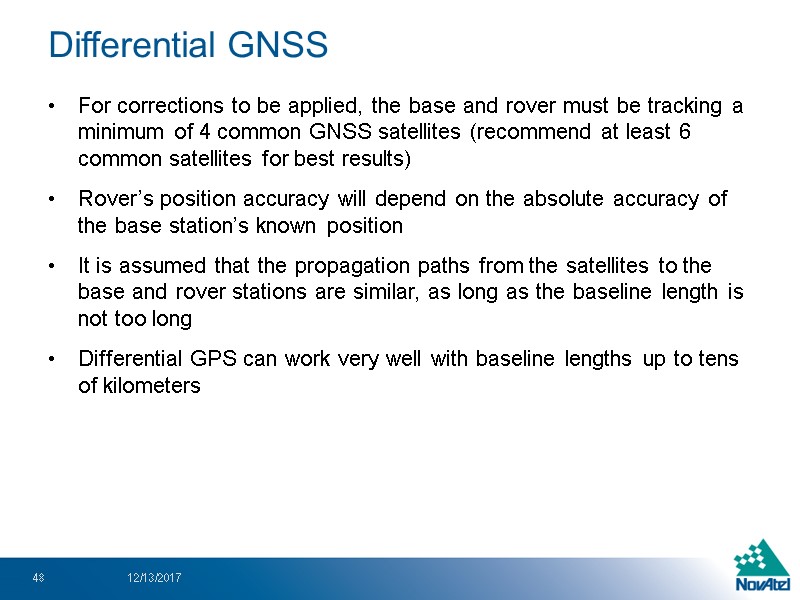
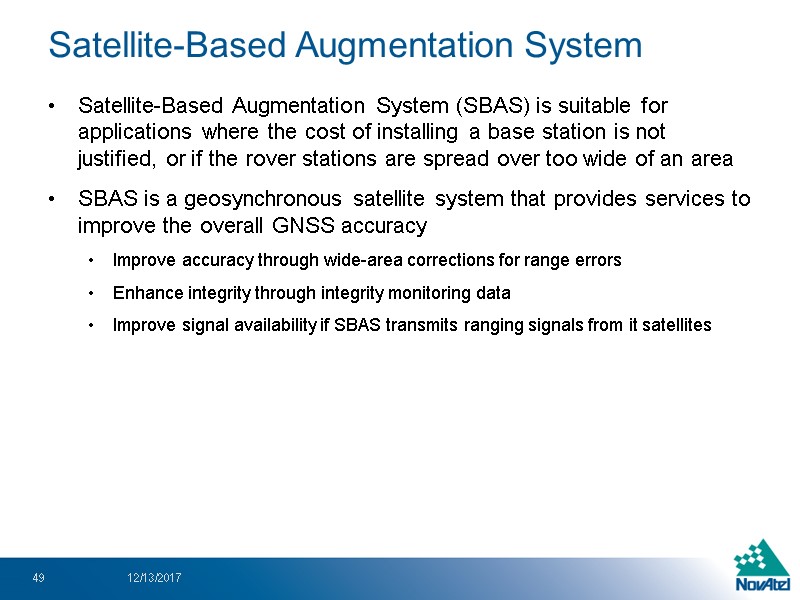
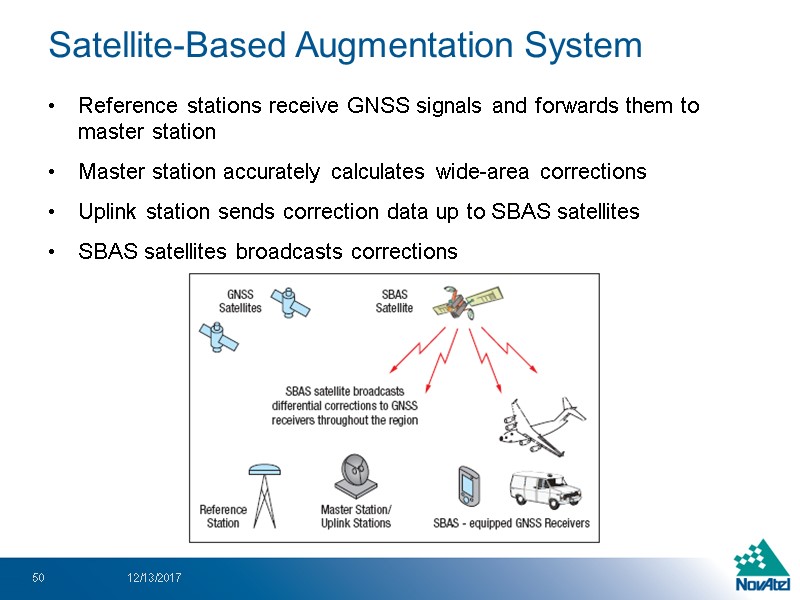
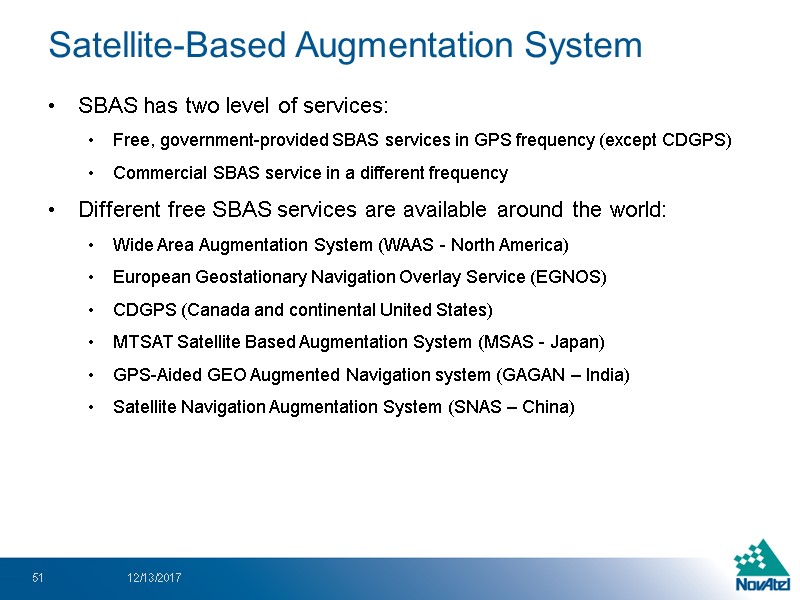
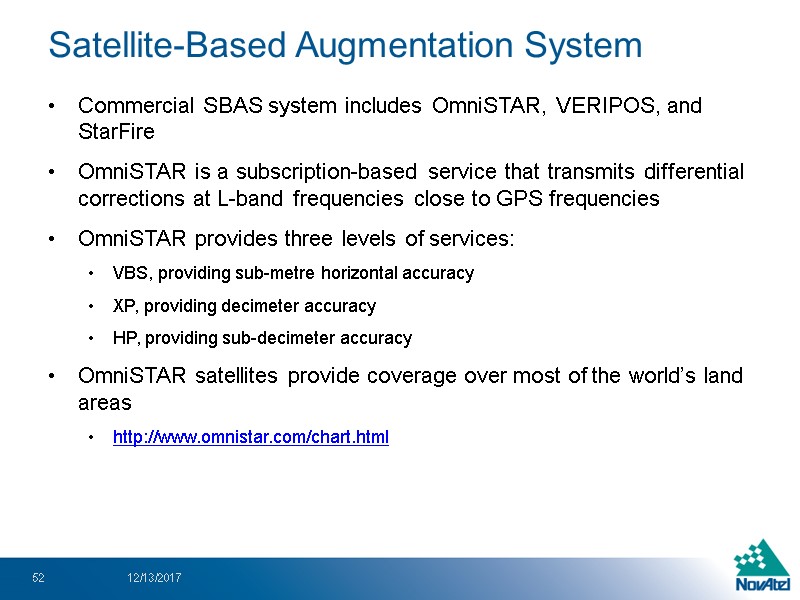
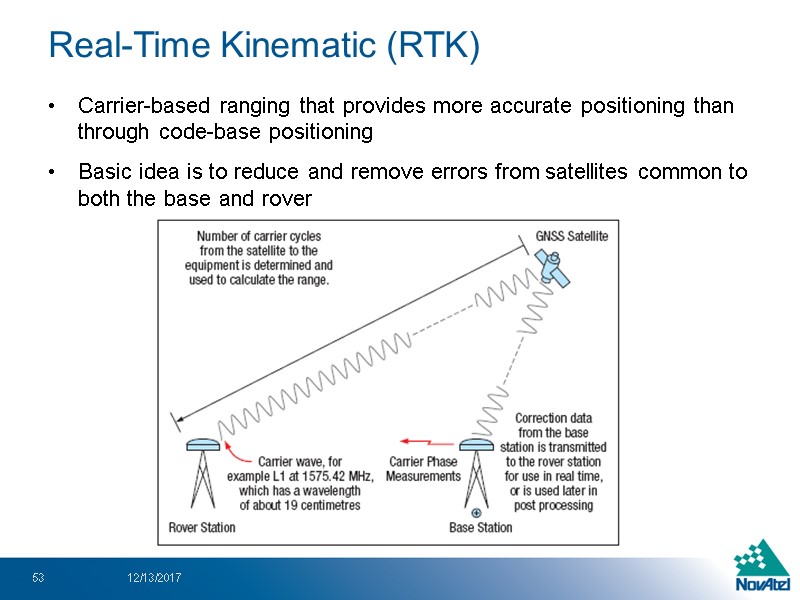
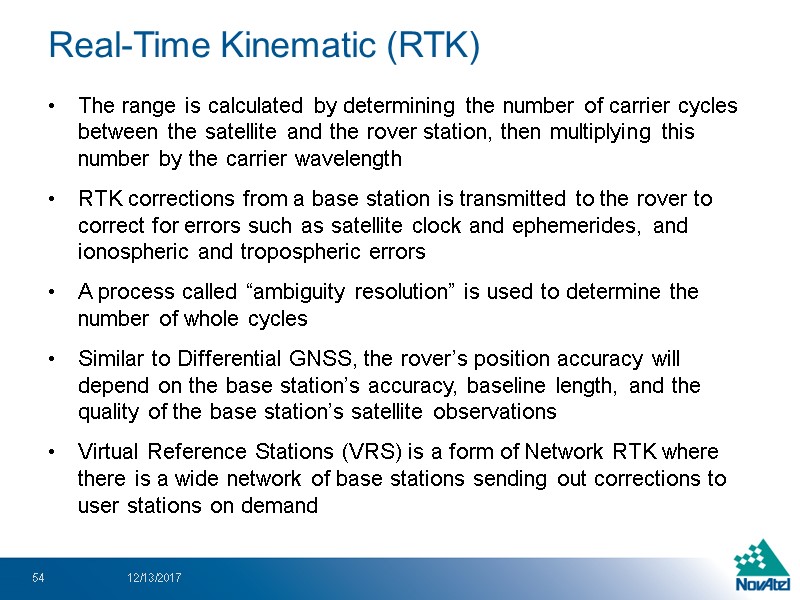
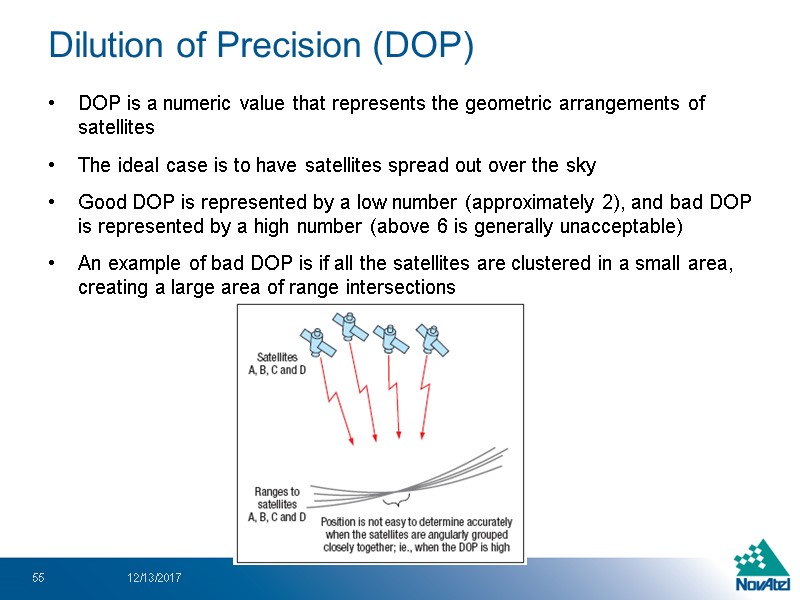
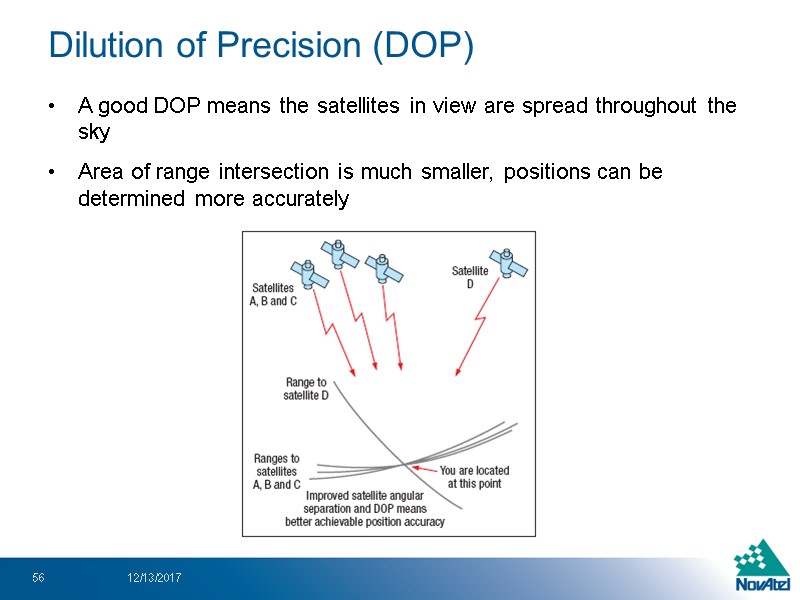
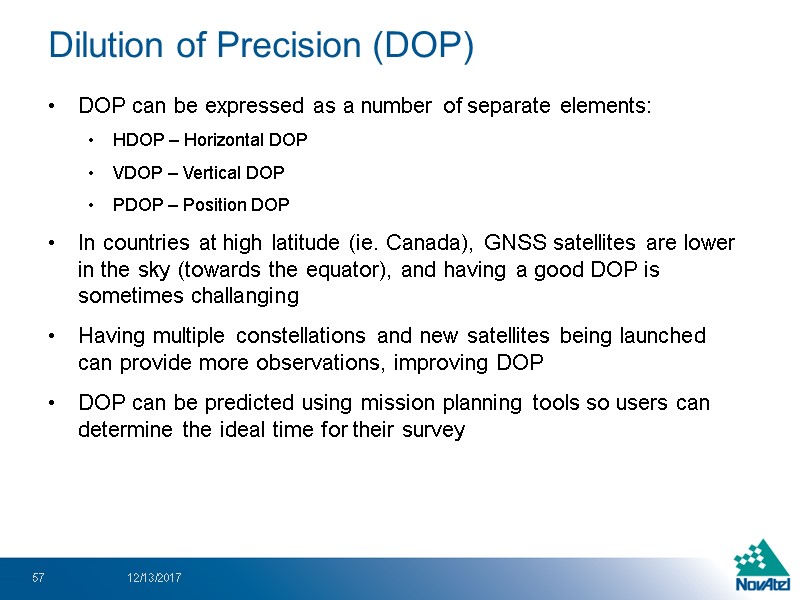
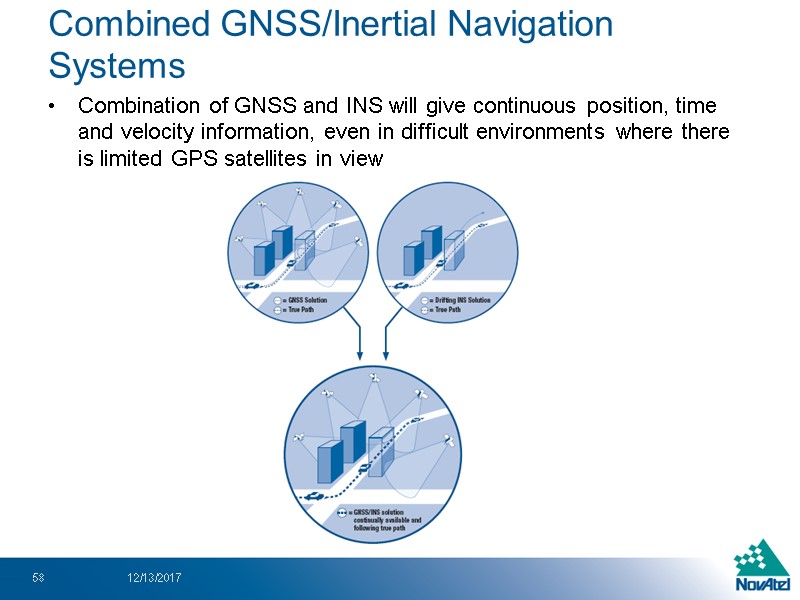
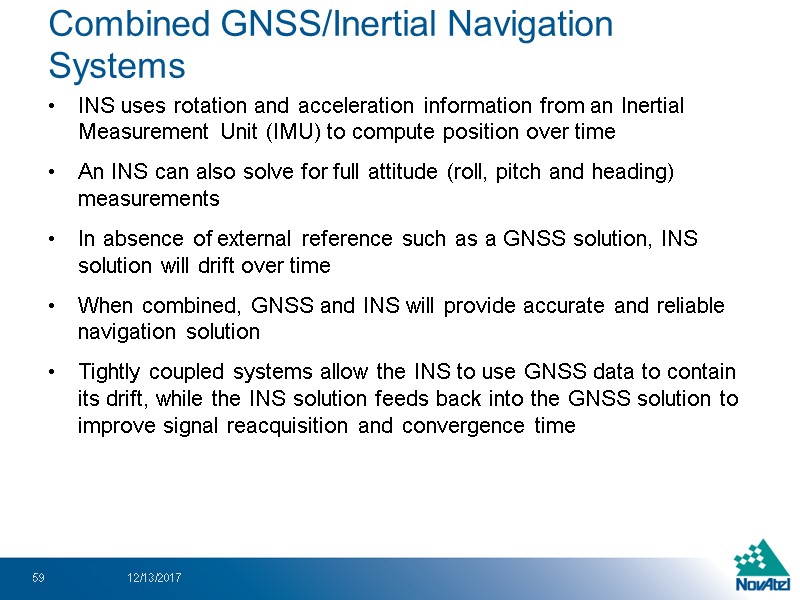
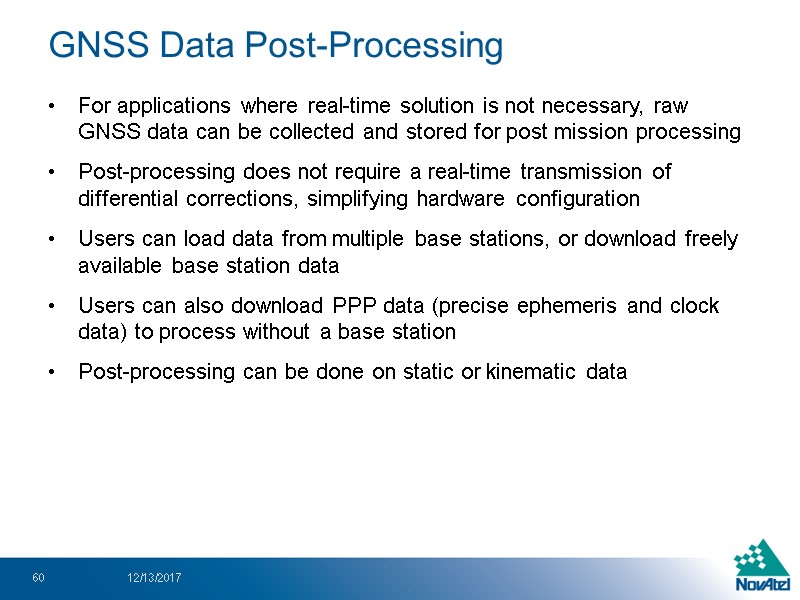
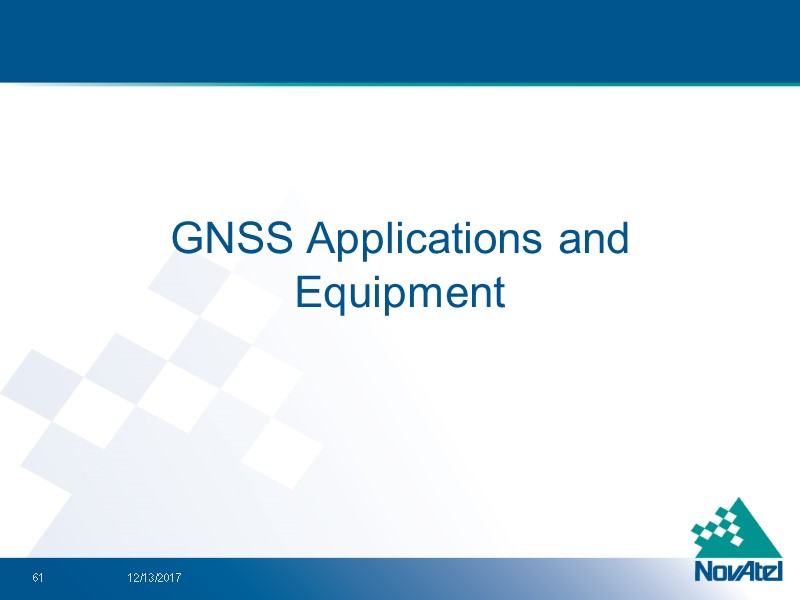
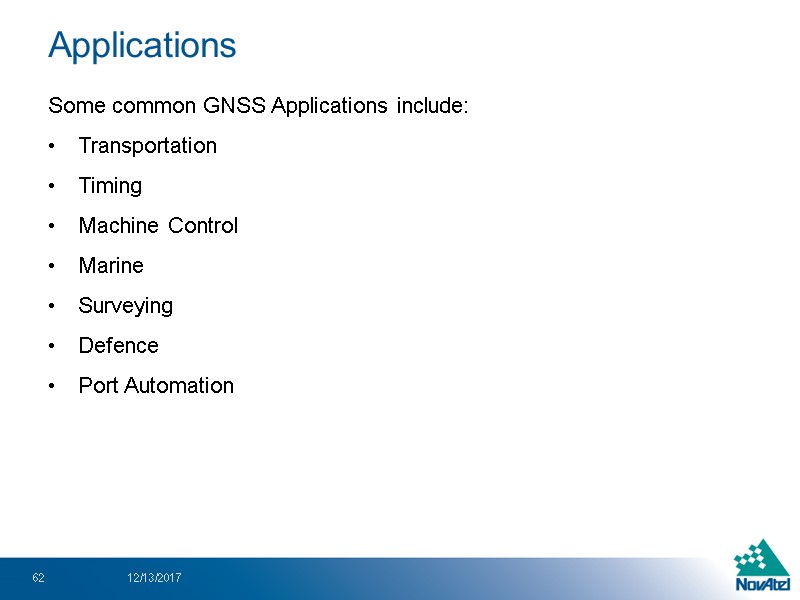
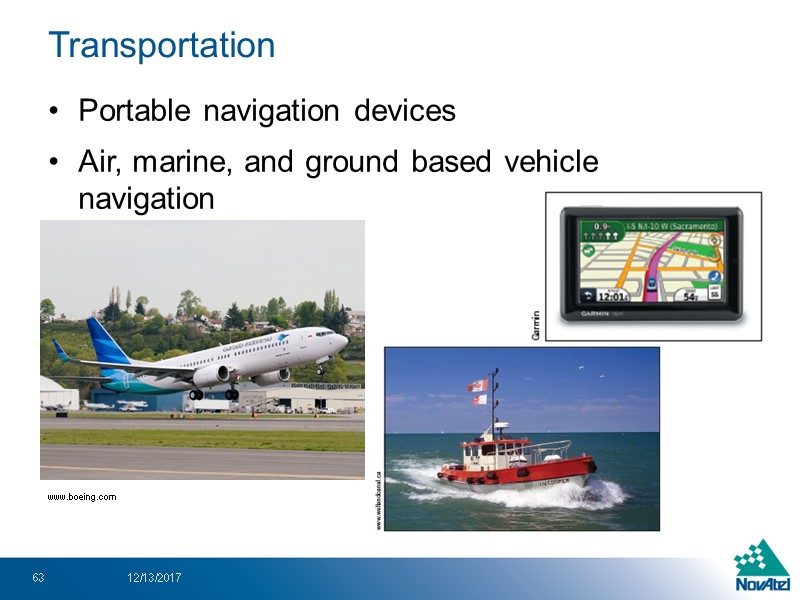
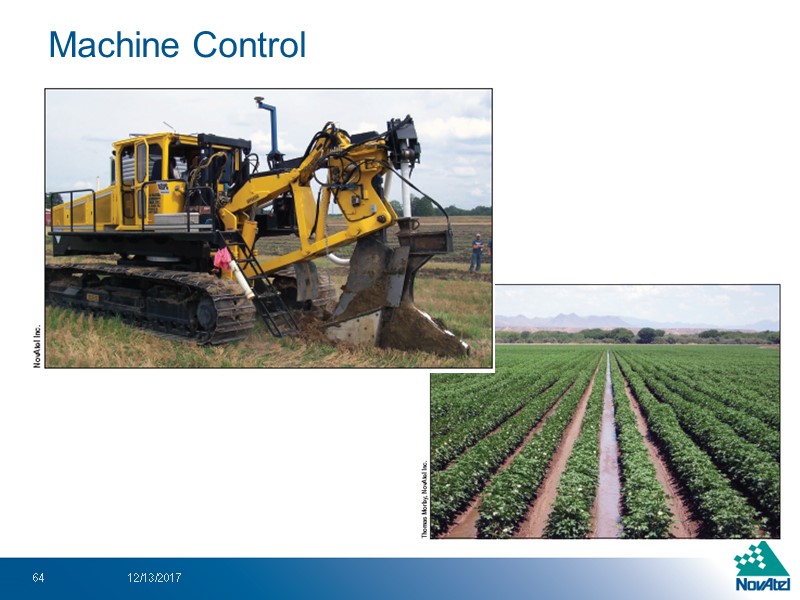
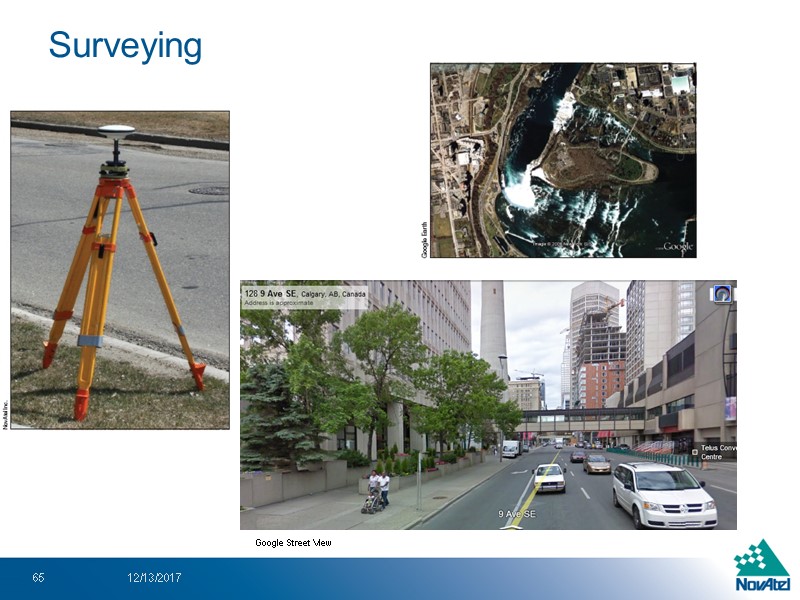
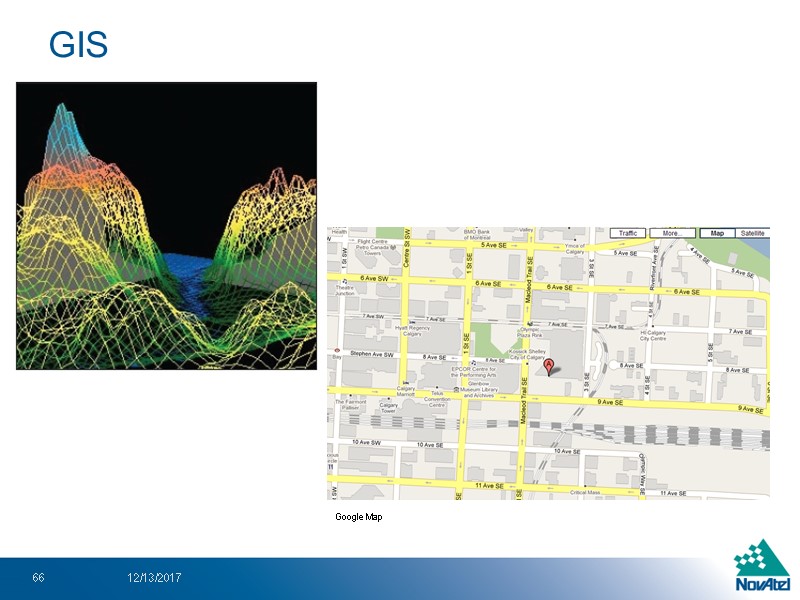
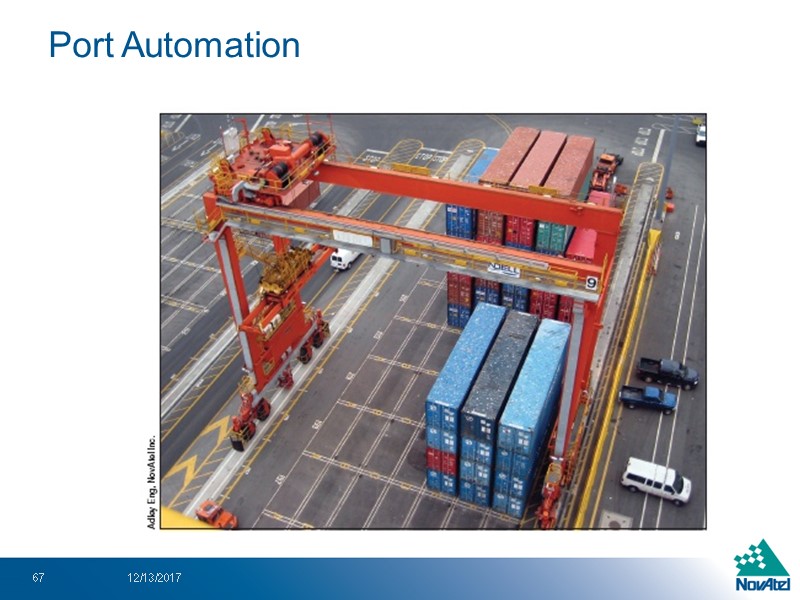
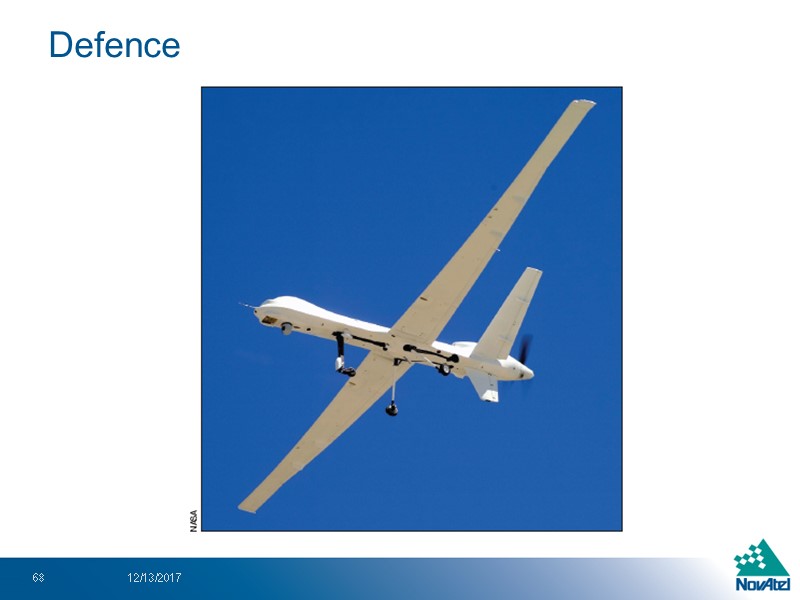
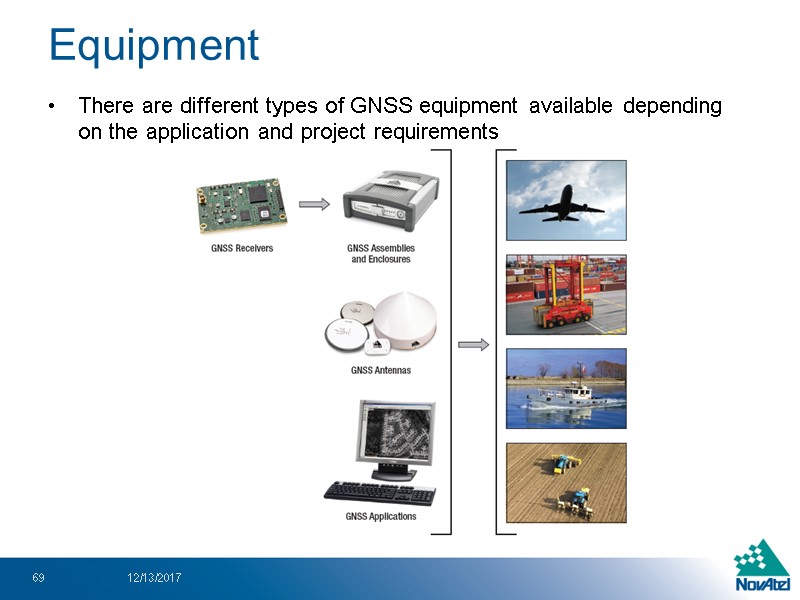
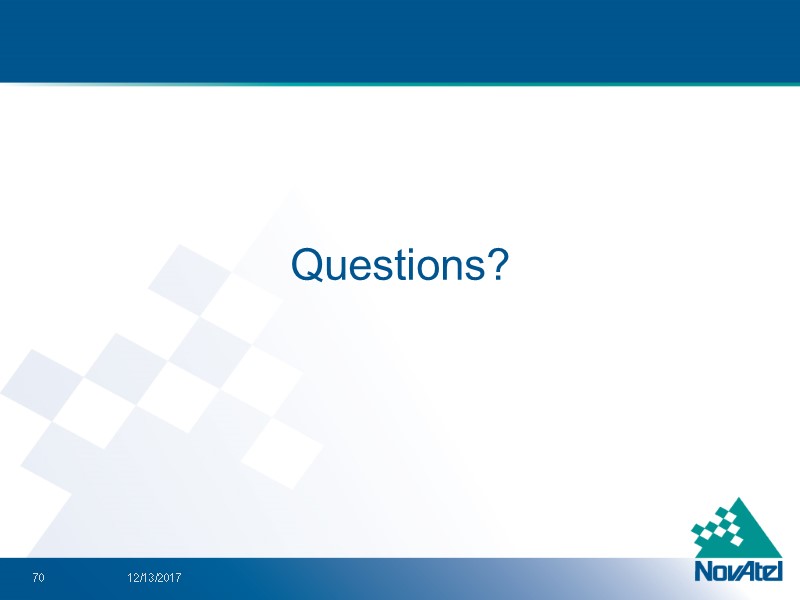
35182-an_introduction_to_gnss_rev2_sd.ppt
- Количество слайдов: 70
 An Introduction to GNSS
An Introduction to GNSS
 Presentation Outline GNSS Overview Basic GNSS Concepts GNSS Satellite Systems Advanced GNSS Concepts GNSS Applications and Equipment 12/13/2017 2
Presentation Outline GNSS Overview Basic GNSS Concepts GNSS Satellite Systems Advanced GNSS Concepts GNSS Applications and Equipment 12/13/2017 2
 GNSS Overview 12/13/2017 3
GNSS Overview 12/13/2017 3
 GNSS Overview GNSS (Global Navigation Satellite Systems) started with the launch of the U.S Department of Defense Global Positioning System (GPS) in the late 1970’s GNSS systems currently include GPS (United States) GLONASS (Russia) Galileo (European Union) BeiDou (China) 12/13/2017 4
GNSS Overview GNSS (Global Navigation Satellite Systems) started with the launch of the U.S Department of Defense Global Positioning System (GPS) in the late 1970’s GNSS systems currently include GPS (United States) GLONASS (Russia) Galileo (European Union) BeiDou (China) 12/13/2017 4
 Architecture GNSS satellite systems consists of three major components or “segments: Space Segment Control Segment User Segment 12/13/2017 5
Architecture GNSS satellite systems consists of three major components or “segments: Space Segment Control Segment User Segment 12/13/2017 5
 Space Segment Consists of GNSS satellites, orbiting about 20,000 km above the earth. Each GNSS has its own constellation of satellites 12/13/2017 6
Space Segment Consists of GNSS satellites, orbiting about 20,000 km above the earth. Each GNSS has its own constellation of satellites 12/13/2017 6
 Control Segment The control segment comprises of a ground-based network of master control stations, data uploading stations, and monitor stations. Master control stations adjust the satellites’ orbit parameters and on-board high-precision clocks when necessary to maintain accuracy Monitor stations monitor the satellites’ signal and status, and relay this information to the master control station Uploading stations uploads any change in satellite status back to the satellites 12/13/2017 7
Control Segment The control segment comprises of a ground-based network of master control stations, data uploading stations, and monitor stations. Master control stations adjust the satellites’ orbit parameters and on-board high-precision clocks when necessary to maintain accuracy Monitor stations monitor the satellites’ signal and status, and relay this information to the master control station Uploading stations uploads any change in satellite status back to the satellites 12/13/2017 7
 User Segment User segment consists of GNSS antennas and receivers used to determine information such as position, velocity, and time 12/13/2017 8
User Segment User segment consists of GNSS antennas and receivers used to determine information such as position, velocity, and time 12/13/2017 8
 Basic GNSS Concepts 12/13/2017 9
Basic GNSS Concepts 12/13/2017 9
 Basic GNSS Concepts 12/13/2017 10 The above figure shows the steps involved in using GNSS to determine time and position then applying the information.
Basic GNSS Concepts 12/13/2017 10 The above figure shows the steps involved in using GNSS to determine time and position then applying the information.
 Satellites Multiple GNSS constellations orbiting the earth Beneficial in difficult environment with obstructions to direct line of sight to satellites. Multiple constellations will give more observations GNSS satellites know their time and orbit ephemerides very accurately Timing accuracy is very important. The time it takes a GNSS signal to travel from satellites to receiver is used to determine distances (range) to satellites 1 microsecond = 300m, 1 nanosecond = 30 cm. Small deviations in time can result in large position errors 12/13/2017 11
Satellites Multiple GNSS constellations orbiting the earth Beneficial in difficult environment with obstructions to direct line of sight to satellites. Multiple constellations will give more observations GNSS satellites know their time and orbit ephemerides very accurately Timing accuracy is very important. The time it takes a GNSS signal to travel from satellites to receiver is used to determine distances (range) to satellites 1 microsecond = 300m, 1 nanosecond = 30 cm. Small deviations in time can result in large position errors 12/13/2017 11
 Satellites GPS transmits at the following frequencies This frequency band is referred to as the L-band, a portion of the radio spectrum between 1 and 2 GHz L1 transmits a navigation message, the coarse acquisition (C/A) code which is freely available to public. An encrypted precision (P) code, called the P(Y) code (restricted access), is transmitted on both L1 and L2. 12/13/2017 12
Satellites GPS transmits at the following frequencies This frequency band is referred to as the L-band, a portion of the radio spectrum between 1 and 2 GHz L1 transmits a navigation message, the coarse acquisition (C/A) code which is freely available to public. An encrypted precision (P) code, called the P(Y) code (restricted access), is transmitted on both L1 and L2. 12/13/2017 12
 Satellites Navigation message includes the following information: GPS date and time Satellite status and health Satellite ephemeris data, which allows the receiver to calculate the satellite’s position. Almanac, which contains information and status for all GPS satellites The P(Y) code is for military use, and provides better interference rejection than the C/A code. Newer GPS satellites now transmits L2 C/A code (L2C), providing a second publicly available code to civilian users. NovAtel can make use of both L2 carrier and code without knowing how it is coded. This is called semi-codeless technology. 12/13/2017 13
Satellites Navigation message includes the following information: GPS date and time Satellite status and health Satellite ephemeris data, which allows the receiver to calculate the satellite’s position. Almanac, which contains information and status for all GPS satellites The P(Y) code is for military use, and provides better interference rejection than the C/A code. Newer GPS satellites now transmits L2 C/A code (L2C), providing a second publicly available code to civilian users. NovAtel can make use of both L2 carrier and code without knowing how it is coded. This is called semi-codeless technology. 12/13/2017 13
 Propagation GNSS signals pass through the near-vacuum of space, then through the various layers of the atmosphere to the earth, as illustrated in the figure below: 12/13/2017 14
Propagation GNSS signals pass through the near-vacuum of space, then through the various layers of the atmosphere to the earth, as illustrated in the figure below: 12/13/2017 14
 Propagation To determine accurate positions, we need to know the range to the satellite. This is the direct path distance from the satellite to the user equipment The signal will “bend” when traveling through the earth’s atmosphere This “bending” increases the amount of time the signal takes to travel from the satellite to the receiver The computed range will contain this propagation time error, or atmospheric error Since the computed range contains errors and is not exactly equal to the actual range, we refer to it as a “pseudorange” 12/13/2017 15
Propagation To determine accurate positions, we need to know the range to the satellite. This is the direct path distance from the satellite to the user equipment The signal will “bend” when traveling through the earth’s atmosphere This “bending” increases the amount of time the signal takes to travel from the satellite to the receiver The computed range will contain this propagation time error, or atmospheric error Since the computed range contains errors and is not exactly equal to the actual range, we refer to it as a “pseudorange” 12/13/2017 15
 Propagation The ionosphere contributes to most of the atmospheric error. It resides at 70 to 1000 km above the earth’s surface. Free electrons resides in the ionosphere, influencing electromagnetic wave propagation Ionospheric delay are frequency dependent. It can be virtually eliminated by calculating the range using both L1 and L2 The troposphere, the lowest layer of the Earth’s atmosphere, contributes to delays due to local temperature, pressure and relative humidity Tropospheric delay cannot be eliminated the way ionospheric delay can be It is possible to model the tropospheric delay then predict and compensate for much of the error 12/13/2017 16
Propagation The ionosphere contributes to most of the atmospheric error. It resides at 70 to 1000 km above the earth’s surface. Free electrons resides in the ionosphere, influencing electromagnetic wave propagation Ionospheric delay are frequency dependent. It can be virtually eliminated by calculating the range using both L1 and L2 The troposphere, the lowest layer of the Earth’s atmosphere, contributes to delays due to local temperature, pressure and relative humidity Tropospheric delay cannot be eliminated the way ionospheric delay can be It is possible to model the tropospheric delay then predict and compensate for much of the error 12/13/2017 16
 Propagation Signals can be reflected on the way to the receiver. This is called “multipath propagation” These reflected signals are delayed from the direct signal, and if strong enough, can interfere with the direct signal Techniques have been developed whereby the receiver only considers the earliest-arriving signals and ignore multipath signals, which arrives later It cannot be entirely eliminated 12/13/2017 17
Propagation Signals can be reflected on the way to the receiver. This is called “multipath propagation” These reflected signals are delayed from the direct signal, and if strong enough, can interfere with the direct signal Techniques have been developed whereby the receiver only considers the earliest-arriving signals and ignore multipath signals, which arrives later It cannot be entirely eliminated 12/13/2017 17
 Reception Receivers need at least 4 satellites to obtain a position. If more are available, these additional observations can be used to improve the position solution GNSS signals are modulated by a unique pseudorandom digital sequence, or code. Each satellite uses a different pseudorandom code Pseudorandom means that the signal appears random, but actually repeats itself after a period of time Receivers know the pseudorandom code for each satellite. This allows receivers to correlate (synchronize) with the GNSS signal to a particular satellite Through code correlation, the receiver is able to recover the signal and the information they contain 12/13/2017 18
Reception Receivers need at least 4 satellites to obtain a position. If more are available, these additional observations can be used to improve the position solution GNSS signals are modulated by a unique pseudorandom digital sequence, or code. Each satellite uses a different pseudorandom code Pseudorandom means that the signal appears random, but actually repeats itself after a period of time Receivers know the pseudorandom code for each satellite. This allows receivers to correlate (synchronize) with the GNSS signal to a particular satellite Through code correlation, the receiver is able to recover the signal and the information they contain 12/13/2017 18
 Reception For each satellite tracked, the receiver determines the propagation time The above figure shows the transmission of a pseudorandom code from a satellite. The receiver can determine the time of propagation by comparing the transmit time to the receive time 12/13/2017 19
Reception For each satellite tracked, the receiver determines the propagation time The above figure shows the transmission of a pseudorandom code from a satellite. The receiver can determine the time of propagation by comparing the transmit time to the receive time 12/13/2017 19
 Computation Range measurments from 4 satellites are needed to determine position For each satellite tracked, the receiver calculates how long the satellite signal took to reach it, which in turn, determines the distance to the satellite: Propagation Time = Time Signal Reached Receiver – Time Signal Left Satellite Distance to Satellite = Propagation Time * Speed of Light Receiver now knows where the satellite was at the time of transmission through the use of orbit ephemerides Through trilateration, the receiver calculates its position 12/13/2017 20
Computation Range measurments from 4 satellites are needed to determine position For each satellite tracked, the receiver calculates how long the satellite signal took to reach it, which in turn, determines the distance to the satellite: Propagation Time = Time Signal Reached Receiver – Time Signal Left Satellite Distance to Satellite = Propagation Time * Speed of Light Receiver now knows where the satellite was at the time of transmission through the use of orbit ephemerides Through trilateration, the receiver calculates its position 12/13/2017 20
 Computation In a two-dimentional world, here is how position calculation works: If receiver acquires two satellites, it has two possible positions: 12/13/2017 21
Computation In a two-dimentional world, here is how position calculation works: If receiver acquires two satellites, it has two possible positions: 12/13/2017 21
 Due to receiver clock error, the intersecting points between the range of satellite A and B do not match with the actual position Receiver clocks are not nearly as accurate as satellite clocks. Their typical accuracy is only about 5 parts per million. When multiplied by the speed of light, the resulting accuracy is within +/- 1500 meters 12/13/2017 22 Computation
Due to receiver clock error, the intersecting points between the range of satellite A and B do not match with the actual position Receiver clocks are not nearly as accurate as satellite clocks. Their typical accuracy is only about 5 parts per million. When multiplied by the speed of light, the resulting accuracy is within +/- 1500 meters 12/13/2017 22 Computation
 When we now compute the range of the third satellite, the points will not intersect to a single computed position The receiver knows that the pseudoranges to the three satellites do not intersect due to receiver clock errors 12/13/2017 23 Computation
When we now compute the range of the third satellite, the points will not intersect to a single computed position The receiver knows that the pseudoranges to the three satellites do not intersect due to receiver clock errors 12/13/2017 23 Computation
 The receiver can advance or delay its clock until the pseudoranges to the three satellites converge at a single point Through this process, the satellite clock has now been “transferred” to the receiver clock, eliminating the receiver clock error The receiver now has both a very accurate position and a very accurate time When you extend this principle to a three-dimensional world, we will need the range of a fourth satellite to compute a position 12/13/2017 24 Computation
The receiver can advance or delay its clock until the pseudoranges to the three satellites converge at a single point Through this process, the satellite clock has now been “transferred” to the receiver clock, eliminating the receiver clock error The receiver now has both a very accurate position and a very accurate time When you extend this principle to a three-dimensional world, we will need the range of a fourth satellite to compute a position 12/13/2017 24 Computation
 In summary, here are the GNSS error sources that affect the accuracy of pseudorange calculation: The degree with which the above pseudorange errors affect positioning accuracy depends largely on the geometry of the satellites being used. This will be discussed later in this training. 12/13/2017 25 Computation
In summary, here are the GNSS error sources that affect the accuracy of pseudorange calculation: The degree with which the above pseudorange errors affect positioning accuracy depends largely on the geometry of the satellites being used. This will be discussed later in this training. 12/13/2017 25 Computation
 GNSS Satellite Systems 12/13/2017 26
GNSS Satellite Systems 12/13/2017 26
 Currently, the following GNSS systems are operational GPS (United States) GLONASS (Russia) The folowing GNSS systems are planned and are in varying stages of development Galileo (European Union) BeiDou (China) The following regional navigation satellite systems are planned and are in varying stages of development: IRNSS (India) QZSS (Japan) 12/13/2017 27 GNSS Satellite Systems
Currently, the following GNSS systems are operational GPS (United States) GLONASS (Russia) The folowing GNSS systems are planned and are in varying stages of development Galileo (European Union) BeiDou (China) The following regional navigation satellite systems are planned and are in varying stages of development: IRNSS (India) QZSS (Japan) 12/13/2017 27 GNSS Satellite Systems
 GPS (Global Positioning System) or NAVSTAR, as it is officially called, is the first GNSS system Launched in the late 1970’s and early 1980’s for the US Department of Defense Since the initial launch, several generations, referred to as “Blocks”, of GPS satellites have been launched GPS was initially launched for military use, but opened up to civilian use in 1983 12/13/2017 28 GPS
GPS (Global Positioning System) or NAVSTAR, as it is officially called, is the first GNSS system Launched in the late 1970’s and early 1980’s for the US Department of Defense Since the initial launch, several generations, referred to as “Blocks”, of GPS satellites have been launched GPS was initially launched for military use, but opened up to civilian use in 1983 12/13/2017 28 GPS
 The GPS space segment is summarized in the table below: The orbital period of each satellite is approximately 12 hours At any point in time, a GPS receiver will have at least 6 satellites in view at any point on Earth under open sky conditions 12/13/2017 29 GPS
The GPS space segment is summarized in the table below: The orbital period of each satellite is approximately 12 hours At any point in time, a GPS receiver will have at least 6 satellites in view at any point on Earth under open sky conditions 12/13/2017 29 GPS
 GPS orbits approximately 26,560 km above the Earth GPS satellites continuously broadcast their identification, ranging signals, satellite status and corrected ephemerides (orbit parameters) Each satellite is identified by their Space Vehicle Number (SVN) and their PseudoRandom code Number (PRN) 12/13/2017 30 GPS
GPS orbits approximately 26,560 km above the Earth GPS satellites continuously broadcast their identification, ranging signals, satellite status and corrected ephemerides (orbit parameters) Each satellite is identified by their Space Vehicle Number (SVN) and their PseudoRandom code Number (PRN) 12/13/2017 30 GPS
 GPS signals are based on CDMA (Code Division Multiple Access) technology The table below provides further information on different GPS frequencies 12/13/2017 31 GPS
GPS signals are based on CDMA (Code Division Multiple Access) technology The table below provides further information on different GPS frequencies 12/13/2017 31 GPS
 GPS Control Segment consists of a master control station and a backup master control station, in addition to monitor stations throughout the world The monitor stations tracks the satellite broadcast signal and pass them on to the master control station where the ephemerides are recalculated. The resulting ephemerides and timing corrections are transmitted back to the satellites through data up-loading stations 12/13/2017 32 GPS
GPS Control Segment consists of a master control station and a backup master control station, in addition to monitor stations throughout the world The monitor stations tracks the satellite broadcast signal and pass them on to the master control station where the ephemerides are recalculated. The resulting ephemerides and timing corrections are transmitted back to the satellites through data up-loading stations 12/13/2017 32 GPS
 GPS space segment modernization has included new signals, as well as improvements in atomic clock accuracy, satellite signal strength and reliability Control segment modernization includes improved ionospheric and trophospheric modelling and in-orbit accuracy, and additional monitoring stations Latest generation of GPS satellites has the capability to transmit new civilian signal, designalted L2C L2C will be easier for the user segment to track and will provide improved navigation accuracy It will also provide the ability to directly measure and remove the ionospheric delay error for a particular satellite, using the civilian signals on both L1 and L2. 12/13/2017 33 GPS Modernization
GPS space segment modernization has included new signals, as well as improvements in atomic clock accuracy, satellite signal strength and reliability Control segment modernization includes improved ionospheric and trophospheric modelling and in-orbit accuracy, and additional monitoring stations Latest generation of GPS satellites has the capability to transmit new civilian signal, designalted L2C L2C will be easier for the user segment to track and will provide improved navigation accuracy It will also provide the ability to directly measure and remove the ionospheric delay error for a particular satellite, using the civilian signals on both L1 and L2. 12/13/2017 33 GPS Modernization
 A new GPS L5 frequency (1176.45 MHz) is slowly being added to new satellites The first NAVSTAR GPS satellite to transmit L5, on a demonstration basis, was launched in 2009 L5 signal is added to meet the requirements of critical safety-of-life applications GPS satellite modernization will also include a new military signal and an improved L1C which will provide greater civilian interoperability with Galileo 12/13/2017 34 GPS Modernization
A new GPS L5 frequency (1176.45 MHz) is slowly being added to new satellites The first NAVSTAR GPS satellite to transmit L5, on a demonstration basis, was launched in 2009 L5 signal is added to meet the requirements of critical safety-of-life applications GPS satellite modernization will also include a new military signal and an improved L1C which will provide greater civilian interoperability with Galileo 12/13/2017 34 GPS Modernization
 GLONASS (Global Navigation Satellite System) was developed by the Soviet Union as an experimental military communications system during the 1970s When the Cold War ended, the Soviet Union recognized that GLONASS can be used in commercial applications First satellite was launched in 1983, and system declared fully operational in 1993 GLONASS went through a period of performance decline Russia is committed to bring the system back up to operational and set a date of 2011 for full deployment of the system 12/13/2017 35 GLONASS
GLONASS (Global Navigation Satellite System) was developed by the Soviet Union as an experimental military communications system during the 1970s When the Cold War ended, the Soviet Union recognized that GLONASS can be used in commercial applications First satellite was launched in 1983, and system declared fully operational in 1993 GLONASS went through a period of performance decline Russia is committed to bring the system back up to operational and set a date of 2011 for full deployment of the system 12/13/2017 35 GLONASS
 The GLONASS constellation provides visibility to a variable number of satellites, depending on your location The GLONASS space segment consists of 24 satellites in three orbital planes The GLONASS constellation geometry repeats about once every eight days GLONASS satellites orbit 25,510 km above the Earth’s surface. About 1,050 km lower than GPS satellites 12/13/2017 36 GLONASS
The GLONASS constellation provides visibility to a variable number of satellites, depending on your location The GLONASS space segment consists of 24 satellites in three orbital planes The GLONASS constellation geometry repeats about once every eight days GLONASS satellites orbit 25,510 km above the Earth’s surface. About 1,050 km lower than GPS satellites 12/13/2017 36 GLONASS
 The GLONASS control segment consists of the system control center and a network of command tracking stations across Russia Similar to GPS, the GLONASS control segment monitors the status of satellites, determines the ephemerides corrections, and satellite clock offsets with respect to GLONASS time and UTC time Twice a day, it uploads corrections to the satellites 12/13/2017 37 GLONASS
The GLONASS control segment consists of the system control center and a network of command tracking stations across Russia Similar to GPS, the GLONASS control segment monitors the status of satellites, determines the ephemerides corrections, and satellite clock offsets with respect to GLONASS time and UTC time Twice a day, it uploads corrections to the satellites 12/13/2017 37 GLONASS
 GLONASS satellites each transmit on slightly different L1 and L2 frequencies GLONASS satellites transmit the same code at different frequencies, a technique known as FDMA (Frequency Division Multiple Access) The GLONASS system is based on 24 satellites using 12 frequencies. It achieves this by having antipodal satellites transmitting on the same frequency 12/13/2017 38 GLONASS
GLONASS satellites each transmit on slightly different L1 and L2 frequencies GLONASS satellites transmit the same code at different frequencies, a technique known as FDMA (Frequency Division Multiple Access) The GLONASS system is based on 24 satellites using 12 frequencies. It achieves this by having antipodal satellites transmitting on the same frequency 12/13/2017 38 GLONASS
 The GLONASS system is based on 24 satellites using 12 frequencies. It achieves this by having antipodal satellites transmitting on the same frequency Antipodal satellites are in the same orbital plane but are separated by 180 degrees. The paired satellites can transmit on the same frequency because they will never appear at the same time in view of a receiver on the Earth’s surface 12/13/2017 39 GLONASS
The GLONASS system is based on 24 satellites using 12 frequencies. It achieves this by having antipodal satellites transmitting on the same frequency Antipodal satellites are in the same orbital plane but are separated by 180 degrees. The paired satellites can transmit on the same frequency because they will never appear at the same time in view of a receiver on the Earth’s surface 12/13/2017 39 GLONASS
 Europe’s global navigation system Guaranteed global positioning service under civilian control Guaranteed availability of service under all but the most extreme circumstances Suitable for applications where safety is crucial, such as air and ground transportation GIOVE-A and GIOVE-B test satellites are already in orbit 12/13/2017 40 Galileo
Europe’s global navigation system Guaranteed global positioning service under civilian control Guaranteed availability of service under all but the most extreme circumstances Suitable for applications where safety is crucial, such as air and ground transportation GIOVE-A and GIOVE-B test satellites are already in orbit 12/13/2017 40 Galileo
 Once the constellation is operational, Galileo navigation signals will provide coverage at all latitudes Two Galileo Control Centres (GCC) will be located in Europe Data recovered by a global network of twenty Galileo Sensor Stations (GSS) will be sent to the GCC Galileo will provide global Search and Rescue (SAR) function 12/13/2017 41 GNSS Satellite Systems – Galileo
Once the constellation is operational, Galileo navigation signals will provide coverage at all latitudes Two Galileo Control Centres (GCC) will be located in Europe Data recovered by a global network of twenty Galileo Sensor Stations (GSS) will be sent to the GCC Galileo will provide global Search and Rescue (SAR) function 12/13/2017 41 GNSS Satellite Systems – Galileo
 Five Galileo services are proposed: 12/13/2017 42 Galileo
Five Galileo services are proposed: 12/13/2017 42 Galileo
 China’s global navigation system Initial system will provide regional coverage A target of 2015 to begin implementation of GEO and MEO satellites for global coverage Compass will provide two levels of services: Public service for civilian use, and free to users in China Licensed military service, more accurate than public service 12/13/2017 43 BeiDou
China’s global navigation system Initial system will provide regional coverage A target of 2015 to begin implementation of GEO and MEO satellites for global coverage Compass will provide two levels of services: Public service for civilian use, and free to users in China Licensed military service, more accurate than public service 12/13/2017 43 BeiDou
 IRNSS (India Regional Navigation Satellite System, India) Satellite system to provide regional coverage Planned to launch in 2013 QZSS (Quasi-Zenith Satellite System, Japan) A three satellite system that will provide regional communication services and positioning information for the mobile environment 12/13/2017 44 Planned Systems
IRNSS (India Regional Navigation Satellite System, India) Satellite system to provide regional coverage Planned to launch in 2013 QZSS (Quasi-Zenith Satellite System, Japan) A three satellite system that will provide regional communication services and positioning information for the mobile environment 12/13/2017 44 Planned Systems
 Advanced GNSS Concepts
Advanced GNSS Concepts
 Differential GNSS uses a fixed GNSS receiver, referred to as “base station” to transmit corrections to the rover station for improved positioning 12/13/2017 46 Differential GNSS
Differential GNSS uses a fixed GNSS receiver, referred to as “base station” to transmit corrections to the rover station for improved positioning 12/13/2017 46 Differential GNSS
 The base station determines ranges to the GNSS satellites by: Using the code-based positioning technique as described earlier Using the precisely known locations of the base station and the satellites, the location of satellites being determined from the precisely known orbit ephemerides and satellite time The base station computes the GNSS errors by differencing the ranges measured from the above methods The base station sends these computed errors as corrections to the rovers, which will incorporate the corrections into their position calculations A data link between the base and rover stations is required 12/13/2017 47 Differential GNSS
The base station determines ranges to the GNSS satellites by: Using the code-based positioning technique as described earlier Using the precisely known locations of the base station and the satellites, the location of satellites being determined from the precisely known orbit ephemerides and satellite time The base station computes the GNSS errors by differencing the ranges measured from the above methods The base station sends these computed errors as corrections to the rovers, which will incorporate the corrections into their position calculations A data link between the base and rover stations is required 12/13/2017 47 Differential GNSS
 For corrections to be applied, the base and rover must be tracking a minimum of 4 common GNSS satellites (recommend at least 6 common satellites for best results) Rover’s position accuracy will depend on the absolute accuracy of the base station’s known position It is assumed that the propagation paths from the satellites to the base and rover stations are similar, as long as the baseline length is not too long Differential GPS can work very well with baseline lengths up to tens of kilometers 12/13/2017 48 Differential GNSS
For corrections to be applied, the base and rover must be tracking a minimum of 4 common GNSS satellites (recommend at least 6 common satellites for best results) Rover’s position accuracy will depend on the absolute accuracy of the base station’s known position It is assumed that the propagation paths from the satellites to the base and rover stations are similar, as long as the baseline length is not too long Differential GPS can work very well with baseline lengths up to tens of kilometers 12/13/2017 48 Differential GNSS
 Satellite-Based Augmentation System (SBAS) is suitable for applications where the cost of installing a base station is not justified, or if the rover stations are spread over too wide of an area SBAS is a geosynchronous satellite system that provides services to improve the overall GNSS accuracy Improve accuracy through wide-area corrections for range errors Enhance integrity through integrity monitoring data Improve signal availability if SBAS transmits ranging signals from it satellites 12/13/2017 49 Satellite-Based Augmentation System
Satellite-Based Augmentation System (SBAS) is suitable for applications where the cost of installing a base station is not justified, or if the rover stations are spread over too wide of an area SBAS is a geosynchronous satellite system that provides services to improve the overall GNSS accuracy Improve accuracy through wide-area corrections for range errors Enhance integrity through integrity monitoring data Improve signal availability if SBAS transmits ranging signals from it satellites 12/13/2017 49 Satellite-Based Augmentation System
 Reference stations receive GNSS signals and forwards them to master station Master station accurately calculates wide-area corrections Uplink station sends correction data up to SBAS satellites SBAS satellites broadcasts corrections 12/13/2017 50 Satellite-Based Augmentation System
Reference stations receive GNSS signals and forwards them to master station Master station accurately calculates wide-area corrections Uplink station sends correction data up to SBAS satellites SBAS satellites broadcasts corrections 12/13/2017 50 Satellite-Based Augmentation System
 SBAS has two level of services: Free, government-provided SBAS services in GPS frequency (except CDGPS) Commercial SBAS service in a different frequency Different free SBAS services are available around the world: Wide Area Augmentation System (WAAS - North America) European Geostationary Navigation Overlay Service (EGNOS) CDGPS (Canada and continental United States) MTSAT Satellite Based Augmentation System (MSAS - Japan) GPS-Aided GEO Augmented Navigation system (GAGAN – India) Satellite Navigation Augmentation System (SNAS – China) 12/13/2017 51 Satellite-Based Augmentation System
SBAS has two level of services: Free, government-provided SBAS services in GPS frequency (except CDGPS) Commercial SBAS service in a different frequency Different free SBAS services are available around the world: Wide Area Augmentation System (WAAS - North America) European Geostationary Navigation Overlay Service (EGNOS) CDGPS (Canada and continental United States) MTSAT Satellite Based Augmentation System (MSAS - Japan) GPS-Aided GEO Augmented Navigation system (GAGAN – India) Satellite Navigation Augmentation System (SNAS – China) 12/13/2017 51 Satellite-Based Augmentation System
 Commercial SBAS system includes OmniSTAR, VERIPOS, and StarFire OmniSTAR is a subscription-based service that transmits differential corrections at L-band frequencies close to GPS frequencies OmniSTAR provides three levels of services: VBS, providing sub-metre horizontal accuracy XP, providing decimeter accuracy HP, providing sub-decimeter accuracy OmniSTAR satellites provide coverage over most of the world’s land areas http://www.omnistar.com/chart.html 12/13/2017 52 Satellite-Based Augmentation System
Commercial SBAS system includes OmniSTAR, VERIPOS, and StarFire OmniSTAR is a subscription-based service that transmits differential corrections at L-band frequencies close to GPS frequencies OmniSTAR provides three levels of services: VBS, providing sub-metre horizontal accuracy XP, providing decimeter accuracy HP, providing sub-decimeter accuracy OmniSTAR satellites provide coverage over most of the world’s land areas http://www.omnistar.com/chart.html 12/13/2017 52 Satellite-Based Augmentation System
 Real-Time Kinematic (RTK) Carrier-based ranging that provides more accurate positioning than through code-base positioning Basic idea is to reduce and remove errors from satellites common to both the base and rover 12/13/2017 53
Real-Time Kinematic (RTK) Carrier-based ranging that provides more accurate positioning than through code-base positioning Basic idea is to reduce and remove errors from satellites common to both the base and rover 12/13/2017 53
 The range is calculated by determining the number of carrier cycles between the satellite and the rover station, then multiplying this number by the carrier wavelength RTK corrections from a base station is transmitted to the rover to correct for errors such as satellite clock and ephemerides, and ionospheric and tropospheric errors A process called “ambiguity resolution” is used to determine the number of whole cycles Similar to Differential GNSS, the rover’s position accuracy will depend on the base station’s accuracy, baseline length, and the quality of the base station’s satellite observations Virtual Reference Stations (VRS) is a form of Network RTK where there is a wide network of base stations sending out corrections to user stations on demand 12/13/2017 54 Real-Time Kinematic (RTK)
The range is calculated by determining the number of carrier cycles between the satellite and the rover station, then multiplying this number by the carrier wavelength RTK corrections from a base station is transmitted to the rover to correct for errors such as satellite clock and ephemerides, and ionospheric and tropospheric errors A process called “ambiguity resolution” is used to determine the number of whole cycles Similar to Differential GNSS, the rover’s position accuracy will depend on the base station’s accuracy, baseline length, and the quality of the base station’s satellite observations Virtual Reference Stations (VRS) is a form of Network RTK where there is a wide network of base stations sending out corrections to user stations on demand 12/13/2017 54 Real-Time Kinematic (RTK)
 Dilution of Precision (DOP) DOP is a numeric value that represents the geometric arrangements of satellites The ideal case is to have satellites spread out over the sky Good DOP is represented by a low number (approximately 2), and bad DOP is represented by a high number (above 6 is generally unacceptable) An example of bad DOP is if all the satellites are clustered in a small area, creating a large area of range intersections 12/13/2017 55
Dilution of Precision (DOP) DOP is a numeric value that represents the geometric arrangements of satellites The ideal case is to have satellites spread out over the sky Good DOP is represented by a low number (approximately 2), and bad DOP is represented by a high number (above 6 is generally unacceptable) An example of bad DOP is if all the satellites are clustered in a small area, creating a large area of range intersections 12/13/2017 55
 Dilution of Precision (DOP) A good DOP means the satellites in view are spread throughout the sky Area of range intersection is much smaller, positions can be determined more accurately 12/13/2017 56
Dilution of Precision (DOP) A good DOP means the satellites in view are spread throughout the sky Area of range intersection is much smaller, positions can be determined more accurately 12/13/2017 56
 DOP can be expressed as a number of separate elements: HDOP – Horizontal DOP VDOP – Vertical DOP PDOP – Position DOP In countries at high latitude (ie. Canada), GNSS satellites are lower in the sky (towards the equator), and having a good DOP is sometimes challanging Having multiple constellations and new satellites being launched can provide more observations, improving DOP DOP can be predicted using mission planning tools so users can determine the ideal time for their survey 12/13/2017 57 Dilution of Precision (DOP)
DOP can be expressed as a number of separate elements: HDOP – Horizontal DOP VDOP – Vertical DOP PDOP – Position DOP In countries at high latitude (ie. Canada), GNSS satellites are lower in the sky (towards the equator), and having a good DOP is sometimes challanging Having multiple constellations and new satellites being launched can provide more observations, improving DOP DOP can be predicted using mission planning tools so users can determine the ideal time for their survey 12/13/2017 57 Dilution of Precision (DOP)
 Combined GNSS/Inertial Navigation Systems Combination of GNSS and INS will give continuous position, time and velocity information, even in difficult environments where there is limited GPS satellites in view 12/13/2017 58
Combined GNSS/Inertial Navigation Systems Combination of GNSS and INS will give continuous position, time and velocity information, even in difficult environments where there is limited GPS satellites in view 12/13/2017 58
 INS uses rotation and acceleration information from an Inertial Measurement Unit (IMU) to compute position over time An INS can also solve for full attitude (roll, pitch and heading) measurements In absence of external reference such as a GNSS solution, INS solution will drift over time When combined, GNSS and INS will provide accurate and reliable navigation solution Tightly coupled systems allow the INS to use GNSS data to contain its drift, while the INS solution feeds back into the GNSS solution to improve signal reacquisition and convergence time 12/13/2017 59 Combined GNSS/Inertial Navigation Systems
INS uses rotation and acceleration information from an Inertial Measurement Unit (IMU) to compute position over time An INS can also solve for full attitude (roll, pitch and heading) measurements In absence of external reference such as a GNSS solution, INS solution will drift over time When combined, GNSS and INS will provide accurate and reliable navigation solution Tightly coupled systems allow the INS to use GNSS data to contain its drift, while the INS solution feeds back into the GNSS solution to improve signal reacquisition and convergence time 12/13/2017 59 Combined GNSS/Inertial Navigation Systems
 GNSS Data Post-Processing For applications where real-time solution is not necessary, raw GNSS data can be collected and stored for post mission processing Post-processing does not require a real-time transmission of differential corrections, simplifying hardware configuration Users can load data from multiple base stations, or download freely available base station data Users can also download PPP data (precise ephemeris and clock data) to process without a base station Post-processing can be done on static or kinematic data 12/13/2017 60
GNSS Data Post-Processing For applications where real-time solution is not necessary, raw GNSS data can be collected and stored for post mission processing Post-processing does not require a real-time transmission of differential corrections, simplifying hardware configuration Users can load data from multiple base stations, or download freely available base station data Users can also download PPP data (precise ephemeris and clock data) to process without a base station Post-processing can be done on static or kinematic data 12/13/2017 60
 GNSS Applications and Equipment 12/13/2017 61
GNSS Applications and Equipment 12/13/2017 61
 Applications Some common GNSS Applications include: Transportation Timing Machine Control Marine Surveying Defence Port Automation 12/13/2017 62
Applications Some common GNSS Applications include: Transportation Timing Machine Control Marine Surveying Defence Port Automation 12/13/2017 62
 Transportation Portable navigation devices Air, marine, and ground based vehicle navigation 12/13/2017 63 www.boeing.com
Transportation Portable navigation devices Air, marine, and ground based vehicle navigation 12/13/2017 63 www.boeing.com
 Machine Control 12/13/2017 64
Machine Control 12/13/2017 64
 Surveying 12/13/2017 65 Google Street View
Surveying 12/13/2017 65 Google Street View
 GIS 12/13/2017 66 Google Map
GIS 12/13/2017 66 Google Map
 Port Automation 12/13/2017 67
Port Automation 12/13/2017 67
 Defence 12/13/2017 68
Defence 12/13/2017 68
 Equipment There are different types of GNSS equipment available depending on the application and project requirements 12/13/2017 69
Equipment There are different types of GNSS equipment available depending on the application and project requirements 12/13/2017 69
 Questions? 12/13/2017 70
Questions? 12/13/2017 70

